This post contains affiliate links.
This article identifies all hummingbirds documented as seen in Alaska and where they are seen in the state. It further identifies if that specific hummingbird species is a year-round resident, a seasonal visitor, or a rare vagrant hummingbird seen in Alaska.
Which Species Of Alaska Hummingbirds Are Found In The State?
There are 5 species of hummingbirds documented as seen in Alaska.
Alaska hummingbirds, listed in order of frequency seen are Rufous, Anna’s, Costa’s, Calliope, and Ruby-throated hummingbirds.
Listed In The Order Of Frequency Seen:
These are the Alaska statistics at the end of 2023, as reported by eBird.org.
Click the “Documented” link below for the current Alaska stats.
Hummingbirds: | Number Seen: | Documented: |
| Rufous | 10,629 | Documented |
| Anna’s | 2,298 | Documented |
| Costa’s | 70 | Documented |
| Calliope | 5 | Documented |
| Ruby-throated | 3 | Documented |
| Total seen: | 13,005 |
These 5 hummingbird species found in Alaska are further classified into three groups:
Year-round residents, Seasonal visitors, and Rare/Vagrant visitors.
| Hummingbirds: | Year-Round, Seasonal, Rare/Vagrant |
| Rufous | Seasonal resident |
| Anna’s | Seasonal resident |
| Costa’s | Rare/vagrant resident |
| Calliope | Rare/vagrant resident |
| Ruby-throated | Rare/vagrant resident |
For more information on Alaska hummingbirds: Read my article: Alaska Hummingbird Migration
Alaska Hummingbirds That Are Year-Round Residents
There are no hummingbirds classified as year-round residents in Alaska.
This hummingbird classification is defined as year-round residents residing in Alaska 365 days a year.
Contrary to popular belief, hummingbirds can withstand far lower temperatures than most people would expect.
Some banded hummingbirds have been observed at temperatures as low as -9 degrees Fahrenheit with a wind chill of -36 degrees Fahrenheit, according to eBird.org.
See my article: 3 Reasons Why Hummingbirds Are Banded
Alaska Hummingbirds That Are Seasonal
There are 2 Alaska hummingbirds classified as seasonal hummingbirds. They are the Rufous and Anna’s hummingbirds.
Hummingbirds that fit within this category are those that migrate through Alaska on a spring or fall emigration basis.
Hummingbirds move south to spend the winter in Mexico and Central America in the fall, after migrating north in the spring to reproduce.
Due to their preference, an ailment, or advanced age, certain seasonal hummingbirds may spend the whole winter in the state.
To see a current sighting map of Alaska’s year-round hummingbirds, click the links below:
RUFOUS HUMMINGBIRD – (Selasphorus rufus)
Conservation Status: Near threatened
Kingdom: Animalia
Phylum: Chordata
Class: Aves
Order: Apodiformes
Family: Trochilidae
Genus: Selasphorus
Species: S. rufous
The Latin word rubrum, which means “red,” is the source of the Rufous Hummingbird’s name due to its reddish-brown color.
Male Rufous hummingbirds:
The orange-red gorget of a male rufous hummingbird is iridescent, and their tail and sides have a rusty hue. Their underside is beige to white, and their bill is black. Along with chocolate brown dorsal feathers, males can also have green plumage with green spots on their rustic-looking backs or on the summit of their heads.
They weigh 3.2 grams and range in length from 2.8 to 3.5 inches.
The metal plate that shields the wearer’s throat during combat to prevent injuries is the inspiration behind the name of the gorget on a male hummingbird. This name is acceptable and fitting to characterize the physical characteristics of male hummingbirds, since they fight fiercely for their own territory.
Read my article: Hummingbird Gorgets Explained
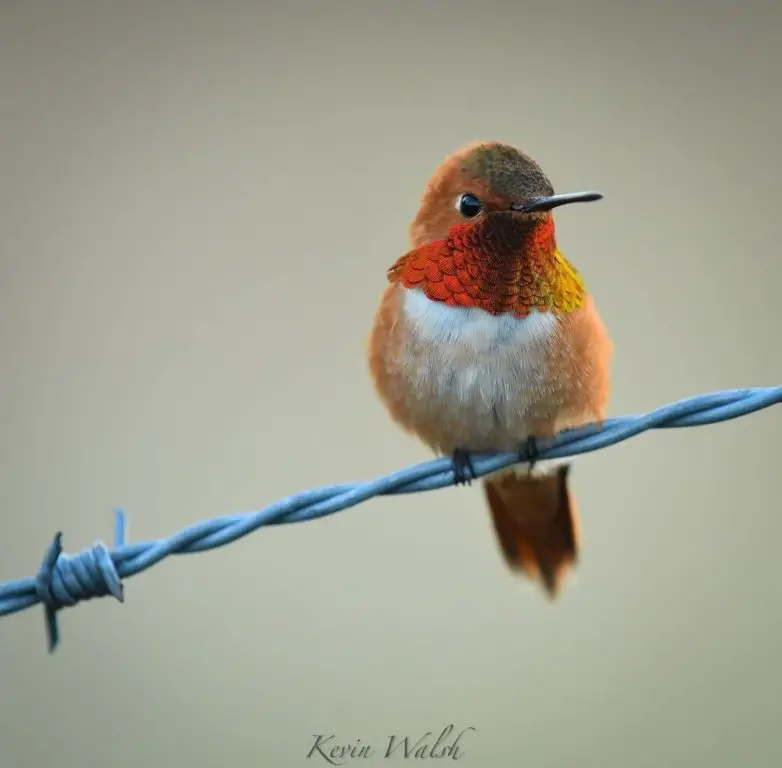
Photo by: Kevin Walsh
Note: The iridescent orange-red gorget.
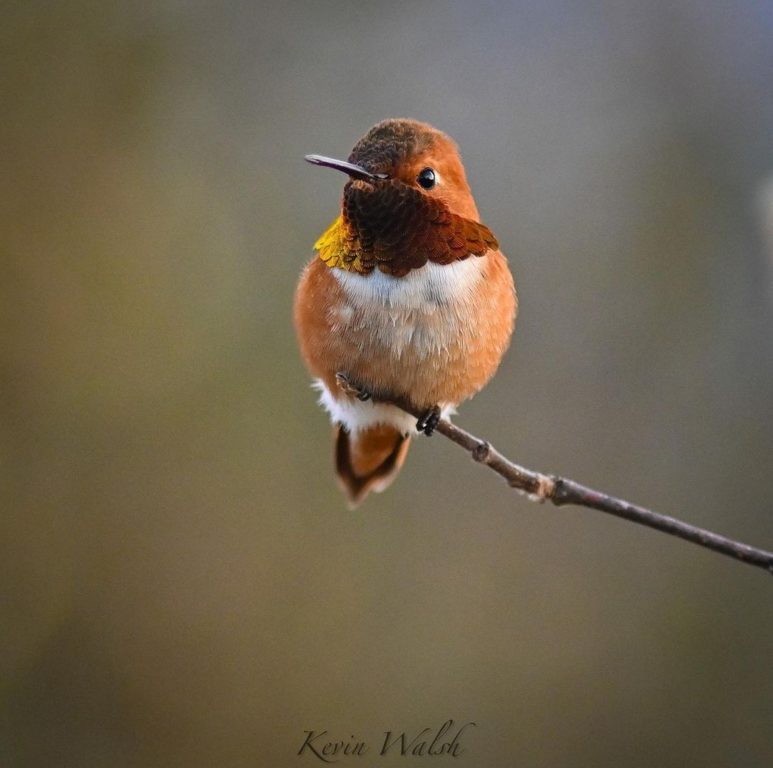
Photo by: Kevin Walsh
Note: The gorget appears chocolate brown in this lighting, however, you can still see a glimmer of his iridescent orange-red gorget with some hints of yellow.
Female Rufous hummingbirds:
The female Rufous hummingbird is less colorful than the male because it lacks a gorget and iridescent feathers. In the wild, confusion may arise, though, because certain females have stippling or color specs along their throat line that resemble juvenile characteristics.
They are slightly larger than the males in anticipation of producing offspring.
See my article: Hummingbird Parents: (Mating to Nesting)
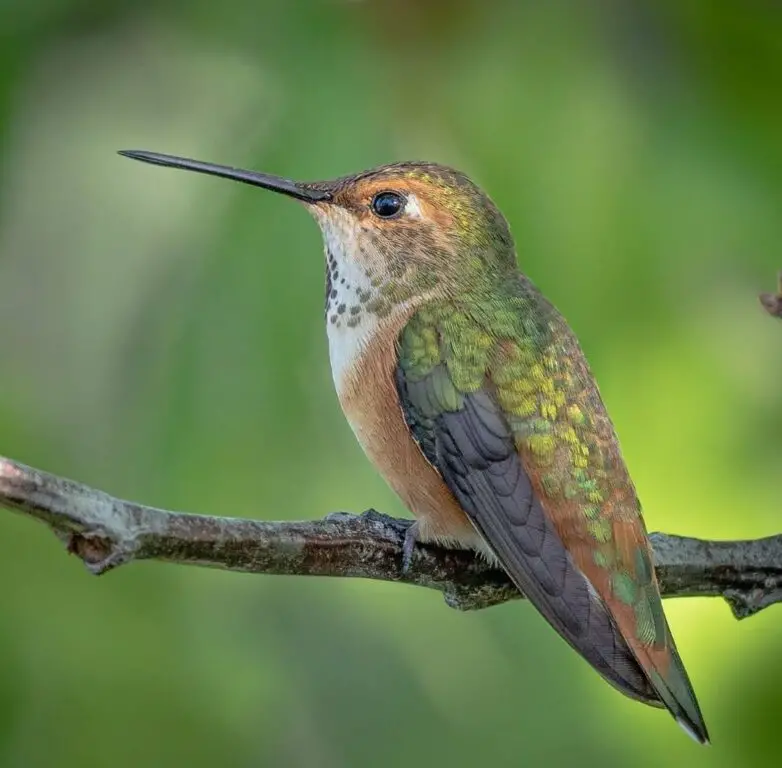
Photo by: Bob Free
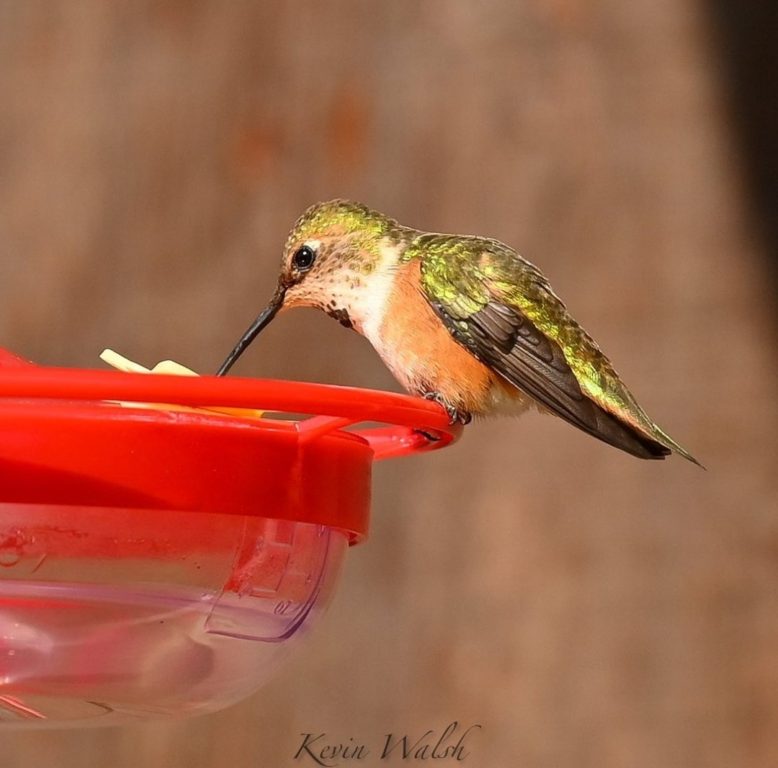
Photo by: Kevin Walsh
They have one of the northernmost breeding ranges of any hummingbird in the world; migrating north from Mexico and nesting as far north as Alaska to breed during the summer months.
They are polygamous and will mate with several partners in a season.
Read my article: Hummingbird Parents: (Mating to Nesting)
Read my article: Baby Hummingbirds: (Egg to Fledgling)
Juvenile Rufous hummingbirds:
In the wild, juvenile Rufous hummingbirds and Allen’s hummingbirds are nearly identical in terms of color and behavior. Therefore, range rather than appearance is used to establish identity.
Juvenile Rufous male’s rustic appearance is attributed to the iridescent orange dots on their neck.
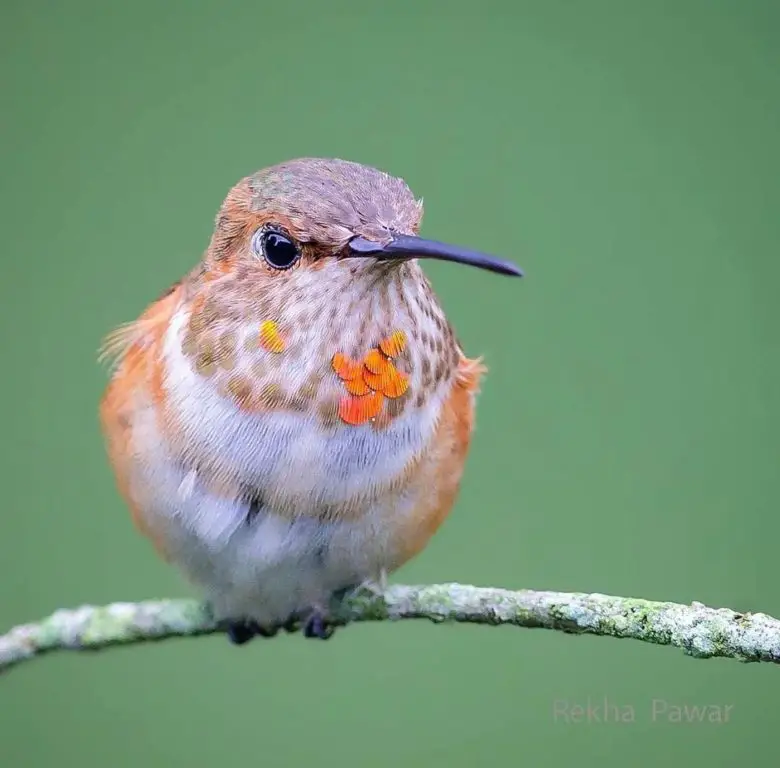
Note: The throat feathers are slowly coming in, displaying a few dots of color near his neckline and showing the first stages of adolescence.
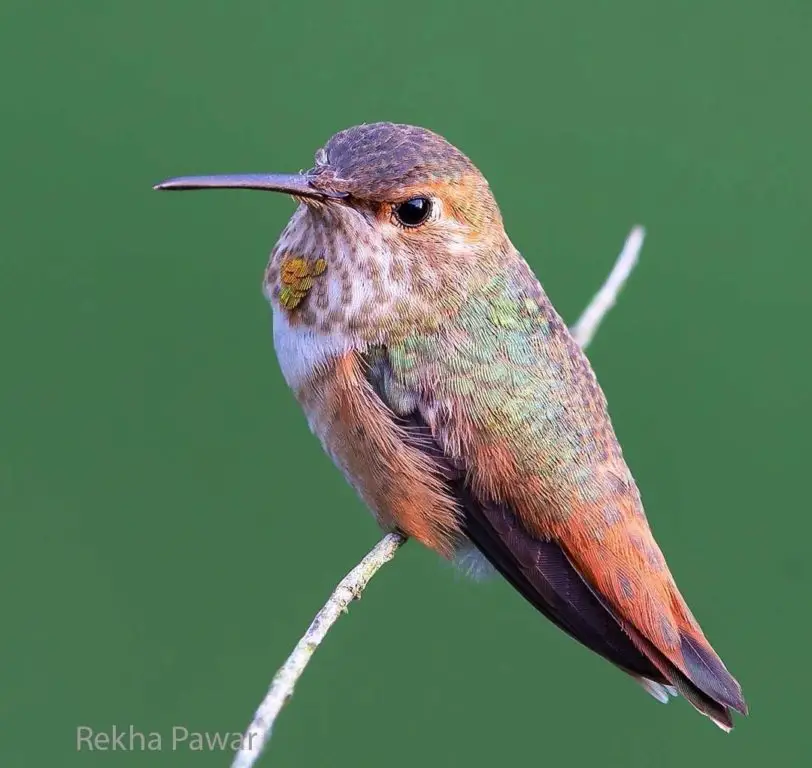
Photo by: Rekha Pawar
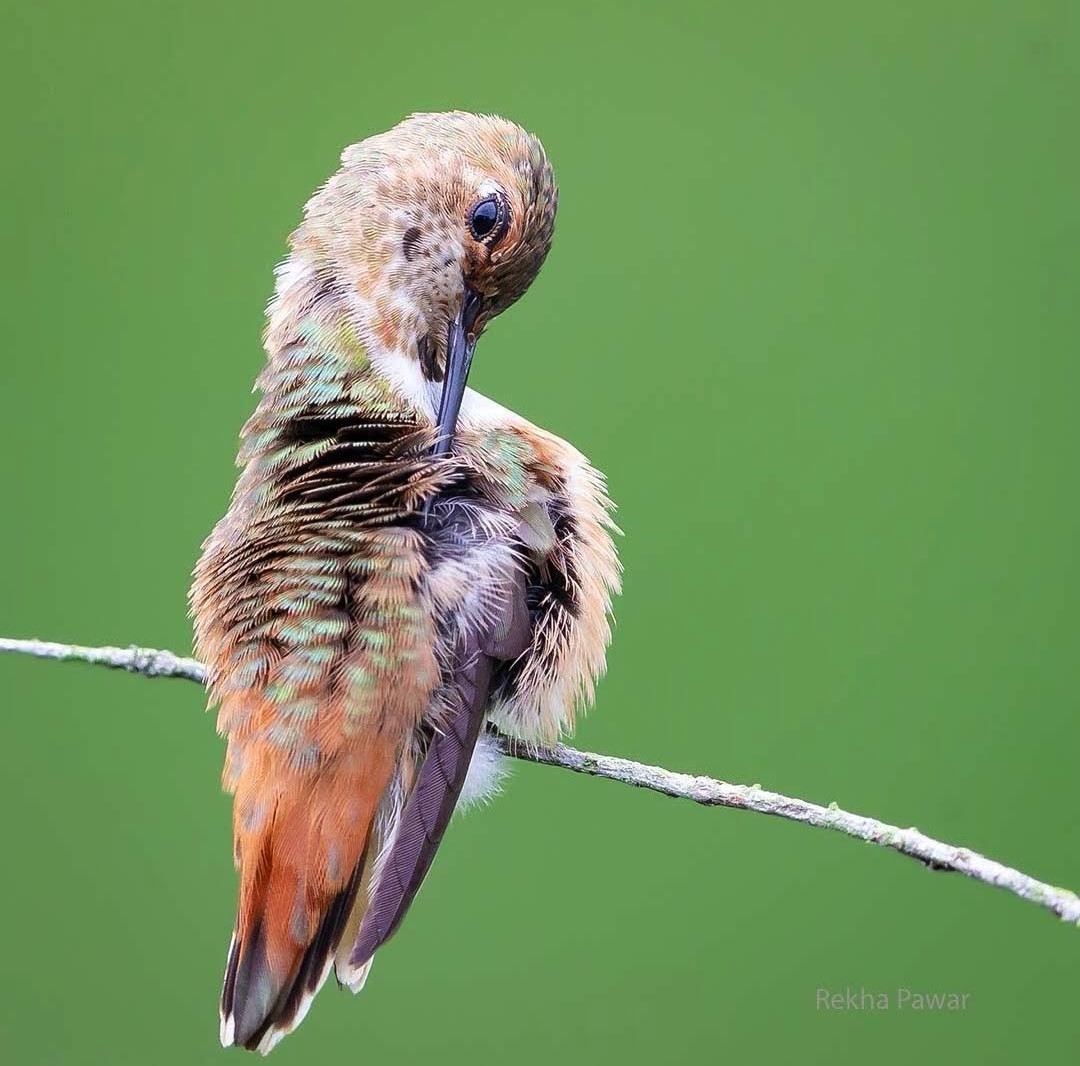
Photo by: Rekha Pawar
Note: Preening flight feathers is an important daily routine to maintain hygiene and to keep the feathers flexible, strong, in alignment, and parasite-free.
Baby Rufous hummingbirds:
Baby Rufous hummingbirds are easily identified by their undertail coverts, which are white fluffy feathers near their bottom that will disappear as they age.
See my article: Baby Hummingbirds: (Egg to Fledgling)
To see the current sighting map of Rufous hummingbirds in Alaska, click the link.
Hear the sounds of the Rufous hummingbird (Cornell Lab of Ornithology link).
82% of all Alaska hummingbird sightings will be Rufous hummingbirds.
On average, out of 10,000 hummingbird sightings in Alaska 8,173 will be the Rufous hummingbird.
Of all the birds in the world, rufous hummingbirds migrate within the United States for the longest period of time. Every year, they traverse 3,900 miles in a clockwise manner around western America.
This migratory pattern during the seasons coordinates their arrival perfectly while catching nectar and blooming flowers throughout the year, fueling their bodies for their long journey.
In order to support a healthy migration, hummingbird enthusiasts are very beneficial when they cultivate blooming plants to draw hummingbirds and supply feeders with homemade hummingbird nectar. These friendly environments offer and guarantee safe trips in addition to a dependable haven for relaxation and refueling while on the road.
A large number of Rufous hummingbirds will choose to move south to Mexico rather than stay in Alaska for the winter. Hummingbirds, however, can withstand far lower temperatures than most people think.
According to eBird.org, through branding practices in Wisconsin, the Rufous and Ruby-throated hummingbirds are documented surviving in temperatures of -9F and wind chills of -36F.
See my article: 3 Reasons Why Hummingbirds Are Banded
Many Alaskahummingbird admirers leave hummingbird feeders up all winter long to provide life-nourishing nectar to the most commonly seen residents: the Anna’s hummingbird.
This selfless act also provides nectar to other injured or older hummingbirds that are unable to migrate.
See my article: 11 DIY Ways to Keep Hummingbird Nectar From Freezing
When it comes to other hummingbirds and animals, Rufous hummingbirds are fiercely possessive and hostile. They are known for being aggressive and bold, driving large birds and rodents away from their favorite feeders in addition to other hummingbirds.
See my article: Why Hummingbirds Chase Each Other: Is it Friend or Foe?
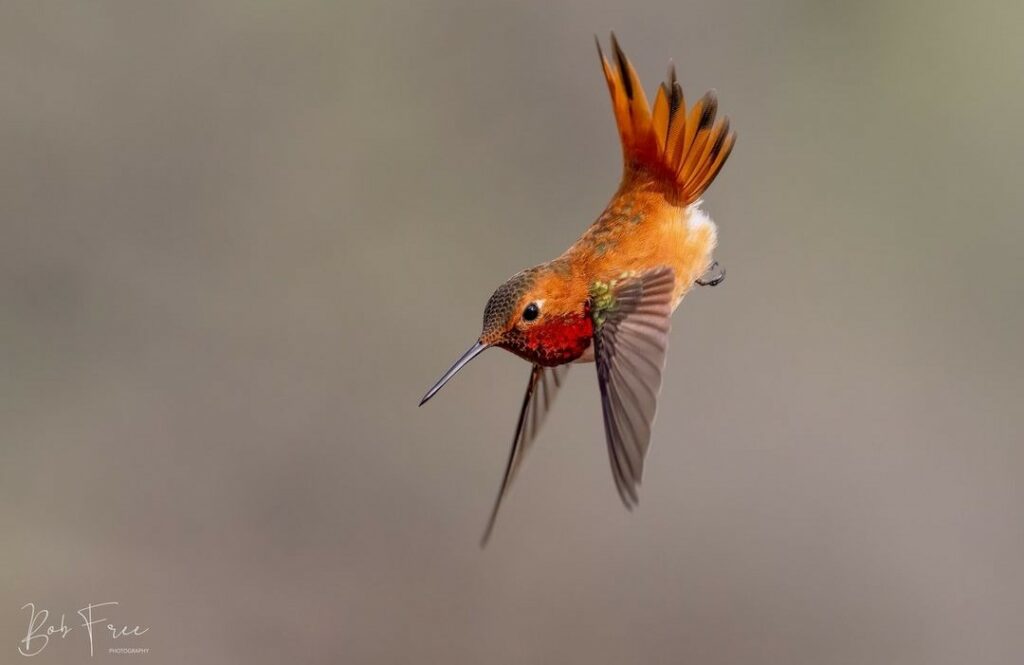
Photo by: Bob Free
It has even been observed that female mothers may attack squirrels and chipmunks that approach their nest too closely.
Due to their remarkable memory, rufous hummingbirds have been observed to search for an abandoned hummingbird feeder years after it has been taken down.
Read my article: Hummingbird Adaptation and Remarkable Ability to Locate Food
Because of their unparalleled flying acrobatics, Rufous hummingbirds are fierce competitors at feeders, outmaneuvering all other species.
With other hummingbird species, including Anna’s hummingbirds, Rufous hummingbirds easily hybridize and crossbreed.
IUCN Red List classifies the Rufous hummingbird as “near threatened” because of habitat destruction in the Pacific Northwest.
In British Columbia, during a banding operation, the oldest living Rufous hummingbird was documented at 8 years and 10 months old.
Read my article: 3 Reasons Why Hummingbirds Are Banded
ANNA’S HUMMINGBIRD – (Calypte anna)
Conservation Status: Least concerned
Kingdom: Animalia
Phylum: Chordata
Class: Aves
Order: Apodiformes
Family: Trochilidae
Genus: Calypte
Species: C. anna
The Anna’s hummingbird, scientifically known as Calypte anna, gets its common name from Anna Masséna, the Duchess of Rivoli.
Male Anna’s hummingbirds:
In North America, male Anna’s hummingbirds are the only species of hummingbirds with a red crown. Their predominant colors are magenta, gray, and green.
The male gorget and crown are iridescent magenta, and they are very vivid and showy.
They weigh between 2.4 and 4.5 grams and have lengths ranging from 3.5 to 4.3 inches.
The metal plate that shields the wearer’s throat during combat to prevent injuries is the inspiration behind the name of the gorget on a male hummingbird. This name is acceptable and fitting to characterize the physical characteristics of male hummingbirds, since they fight fiercely for their own territory.
Read my article: Hummingbird Gorgets Explained
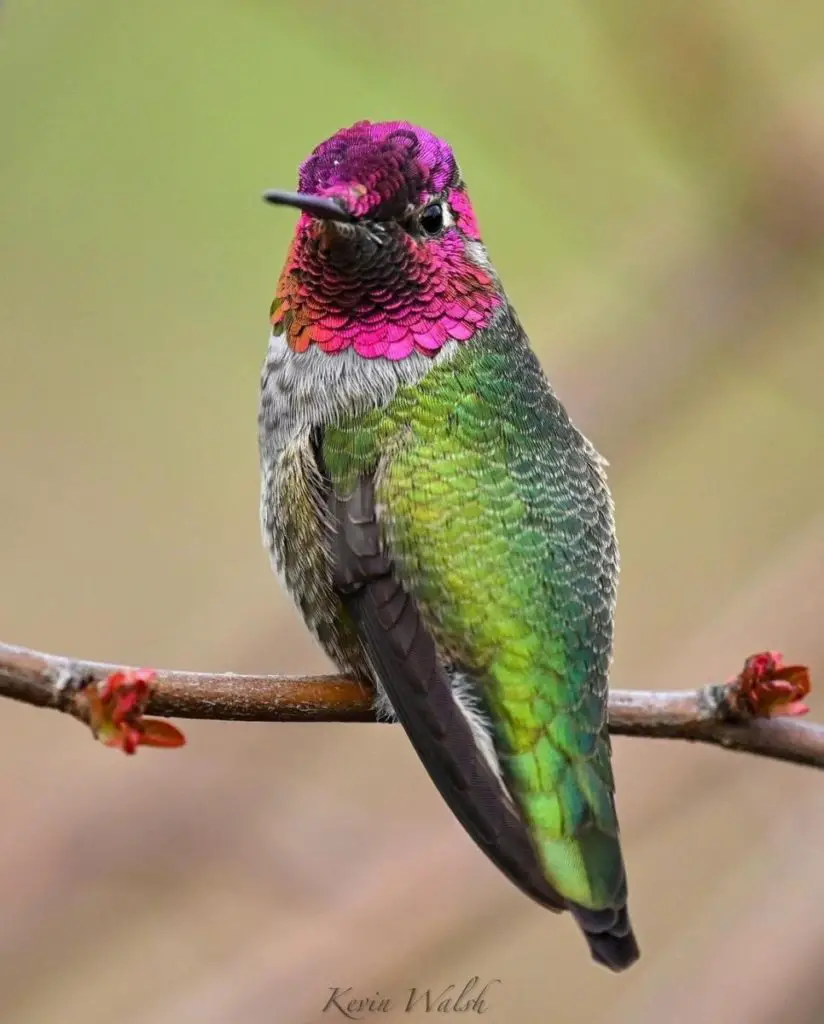
Photo by: Kevin Walsh
Note: The metallic green glossy back with iridescent magenta gorget and crown.
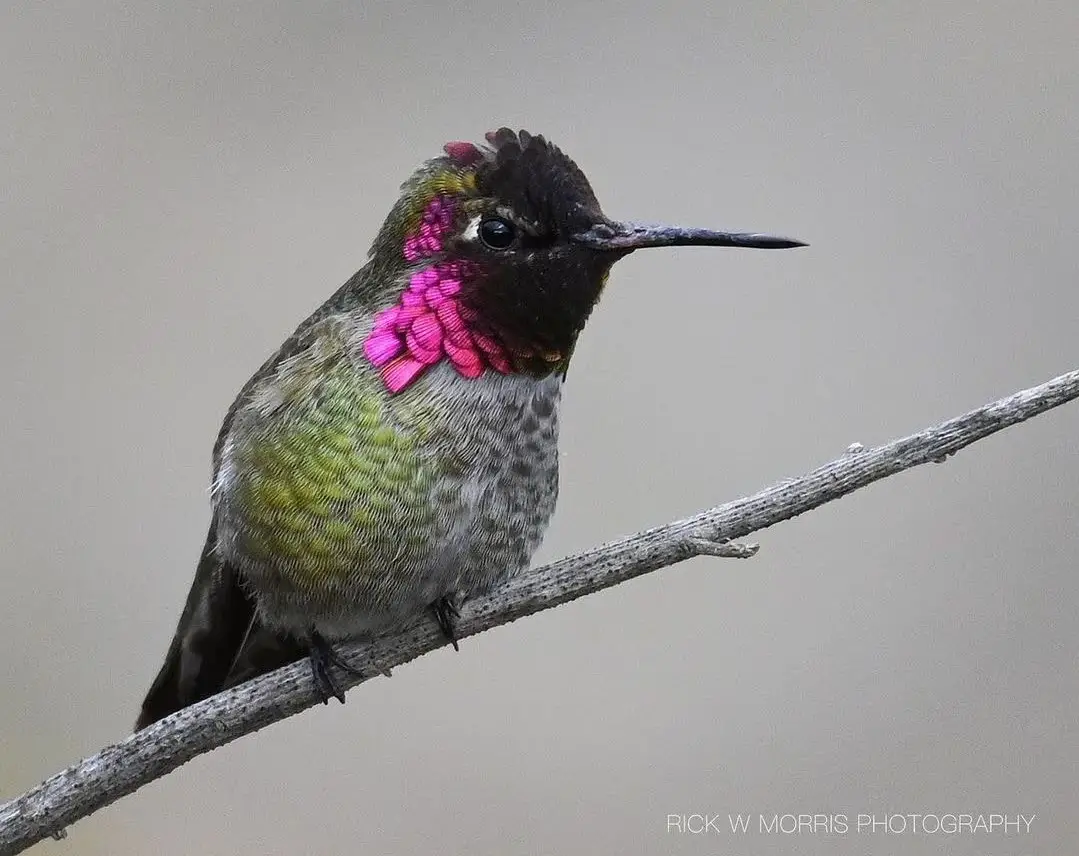
Photo by: IntheWildwithRick
Female Anna’s hummingbirds:
Female Anna’s hummingbirds are pale green in hue, not as brilliant as the males.
Although a showy gorget is more prevalent on the males, females can also have them, showing a tiny area of magenta.
Females are identified by the faint white line that usually covers each eye.
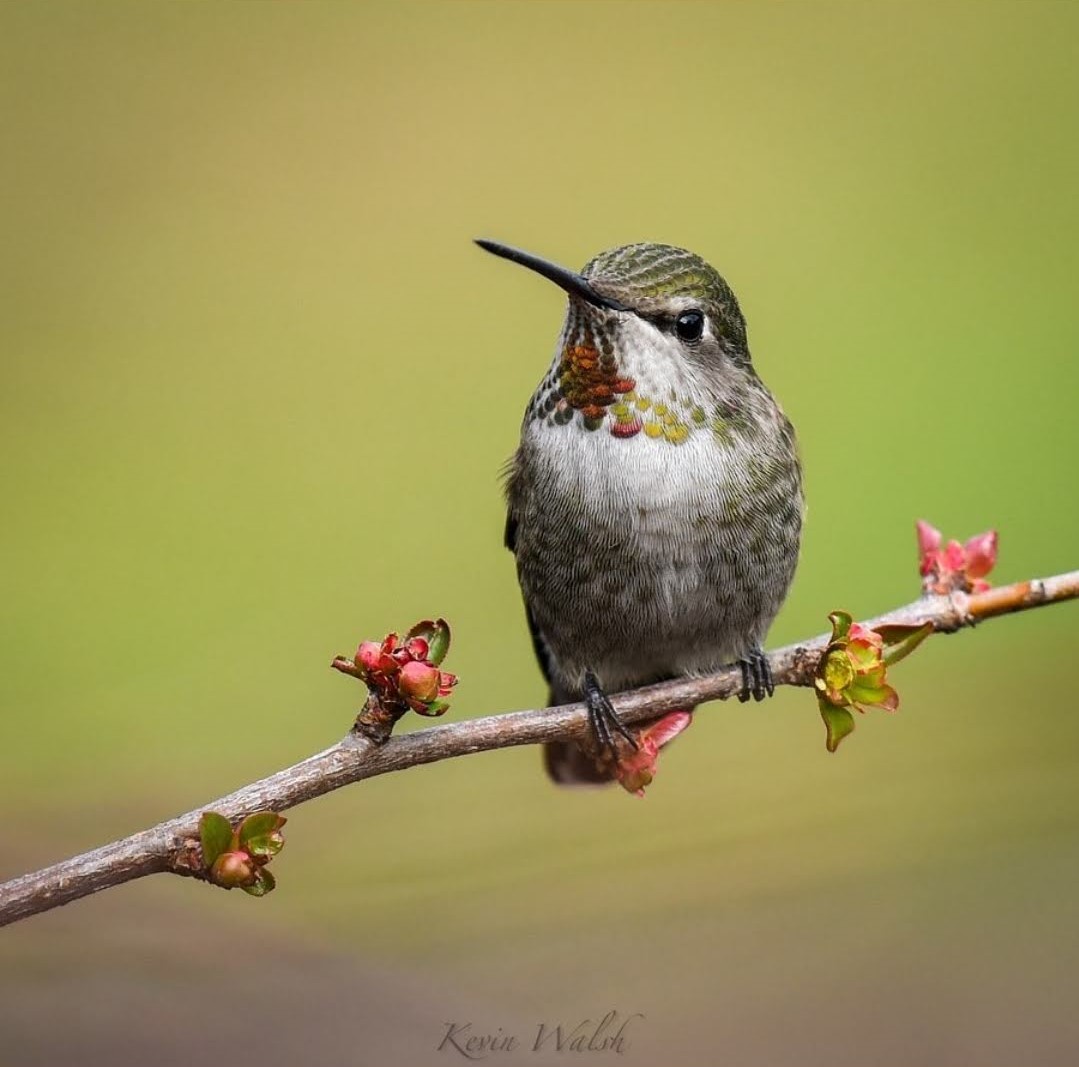
Photo by: Kevin Walsh
Note: The small patch of color on her gorget.
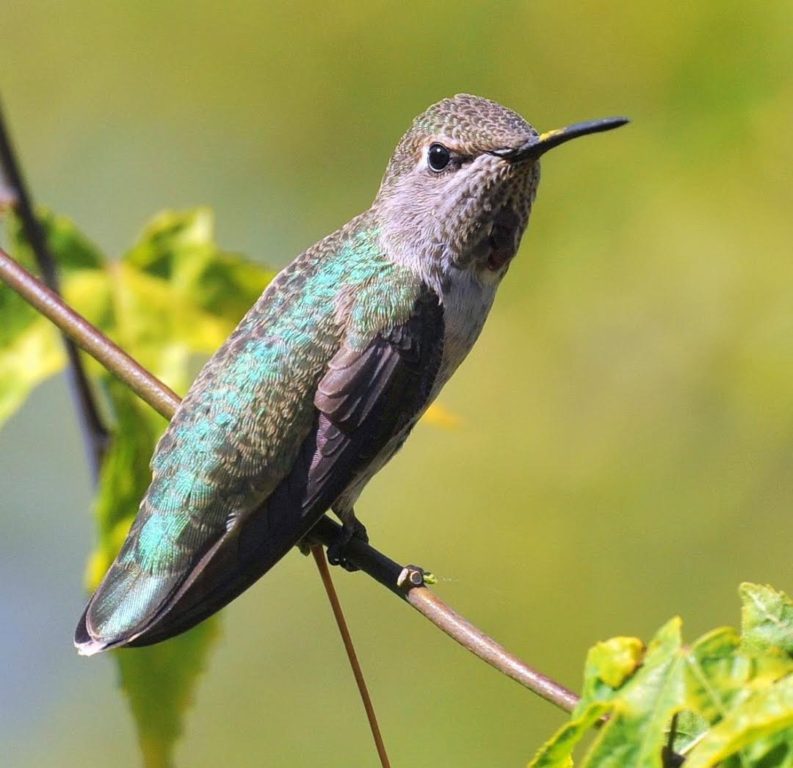
Photo by: IntheWildwithRick
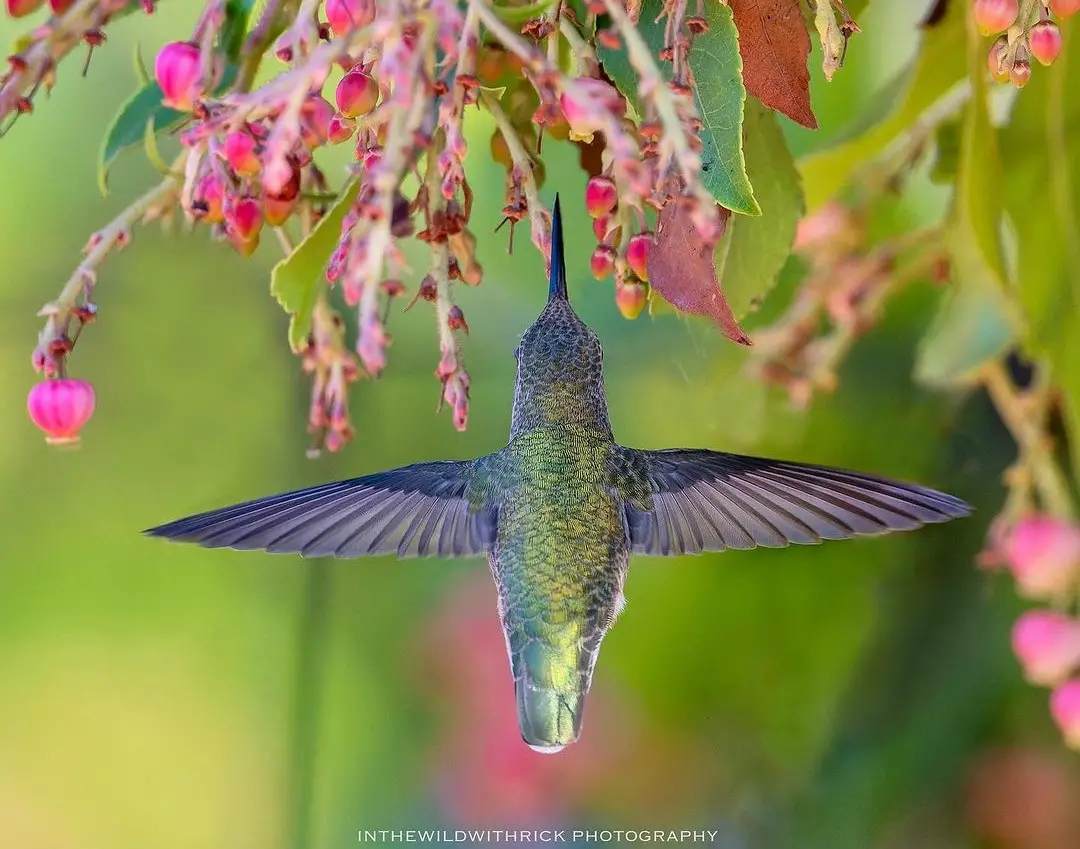
Photo by: IntheWildwithRick
Female Anna’s hummingbirds raise their young with no help from the males.
See my article: Hummingbird Parents: (Mating to Nesting)
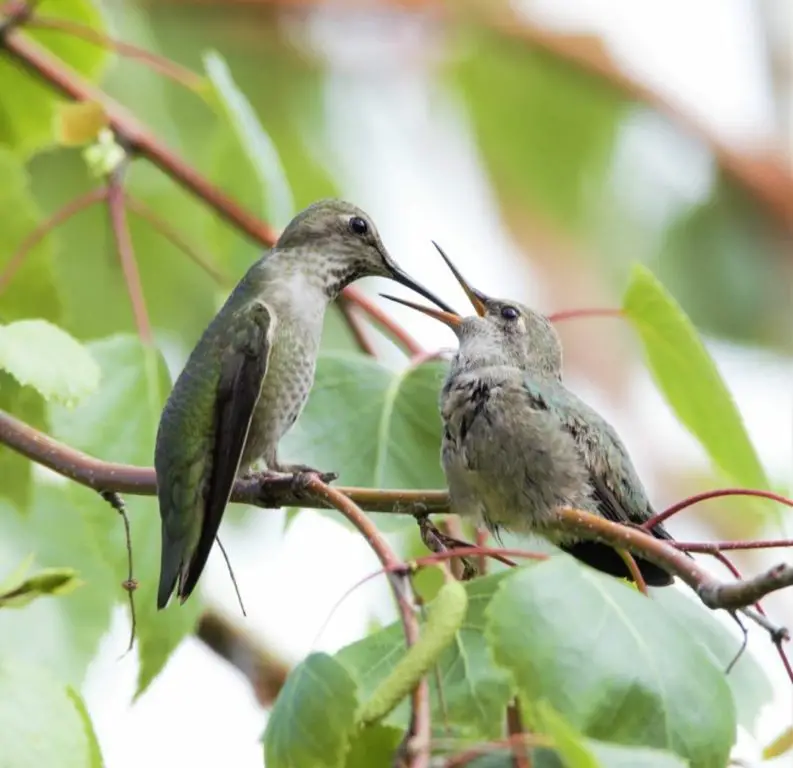
Photo by: Mehta.vishal.360
Juvenile Anna’s hummingbirds:
Juvenile Anna’s hummingbirds, both male and female, look more like adult females until they are differentiated as the male begins to acquire the bright red/magenta gorget.
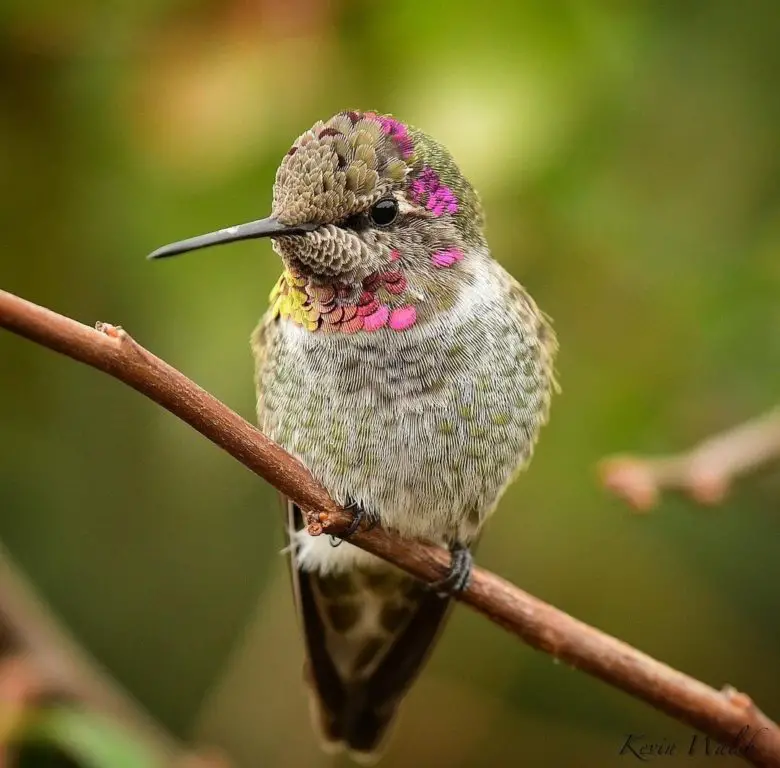
Photo by: Kevin Walsh
Note: This Anna’s hummingbird may be a youngster going through the awkward adolescent years, or it may be in the process of molting.
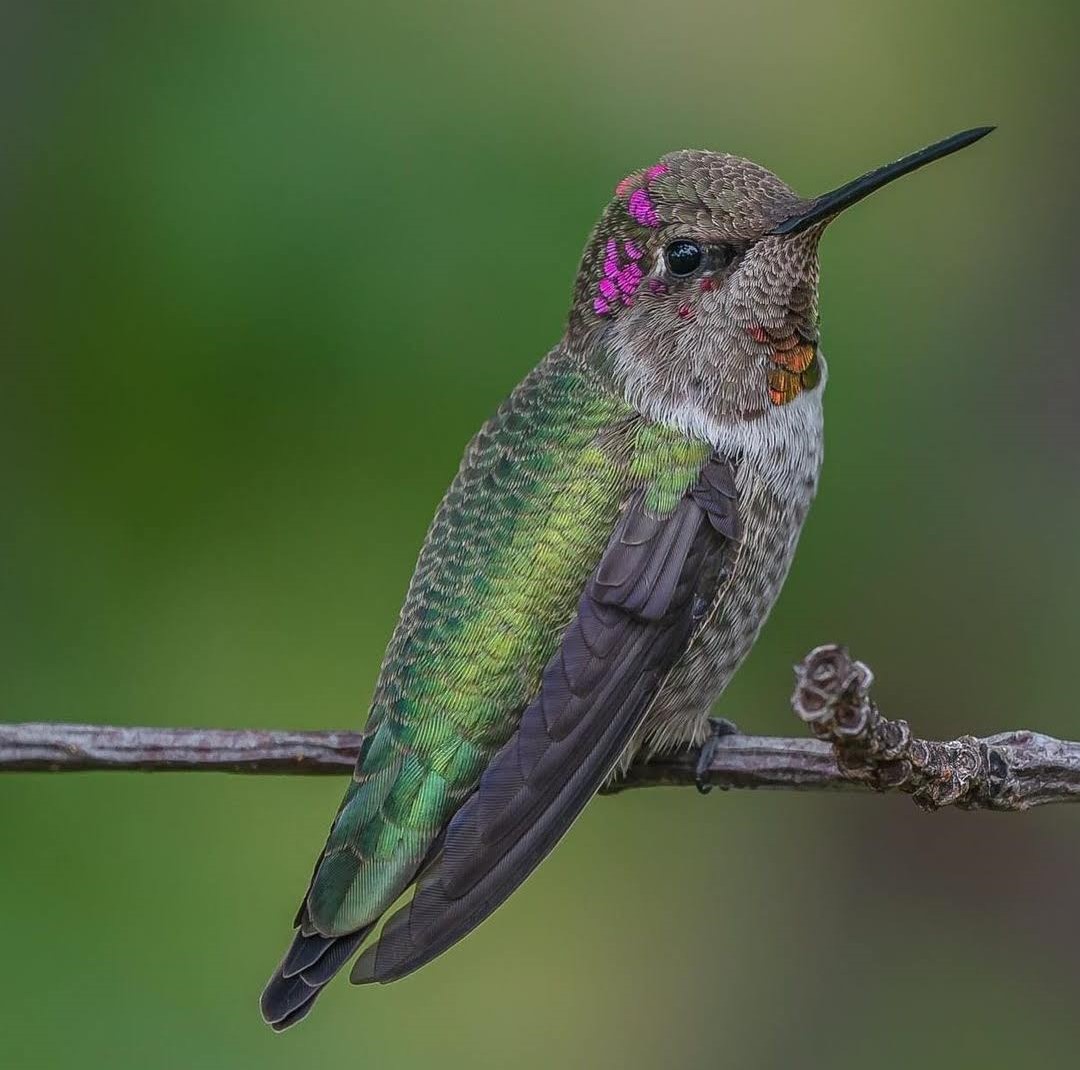
Photo by: Bob Free
Baby Anna’s hummingbirds:
Baby Anna’s hummingbirds are easily identified by their undertail coverts, which are white fluffy feathers near their bottom that will disappear as they age.
See my article: Baby Hummingbirds: (Egg to Fledgling)
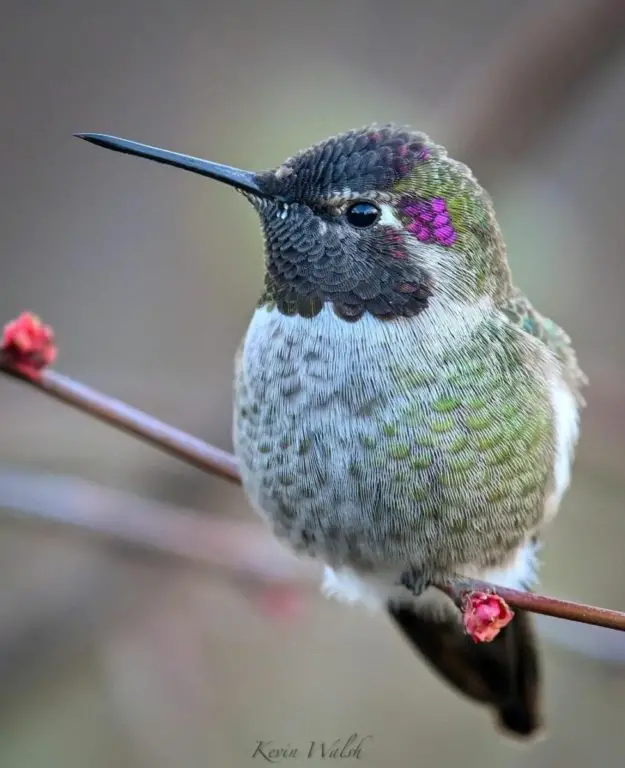
Photo by: Kevin Walsh
Note: The magenta head feathers of this baby/juvenile male Anna’s hummingbird are starting to show at his temple and a hint of color is beginning to appear on his gorget. Also, notice the great fat reserves he has amassed from being fed by his vigilant mother and his newly white fluffy down feathers near his bottom.
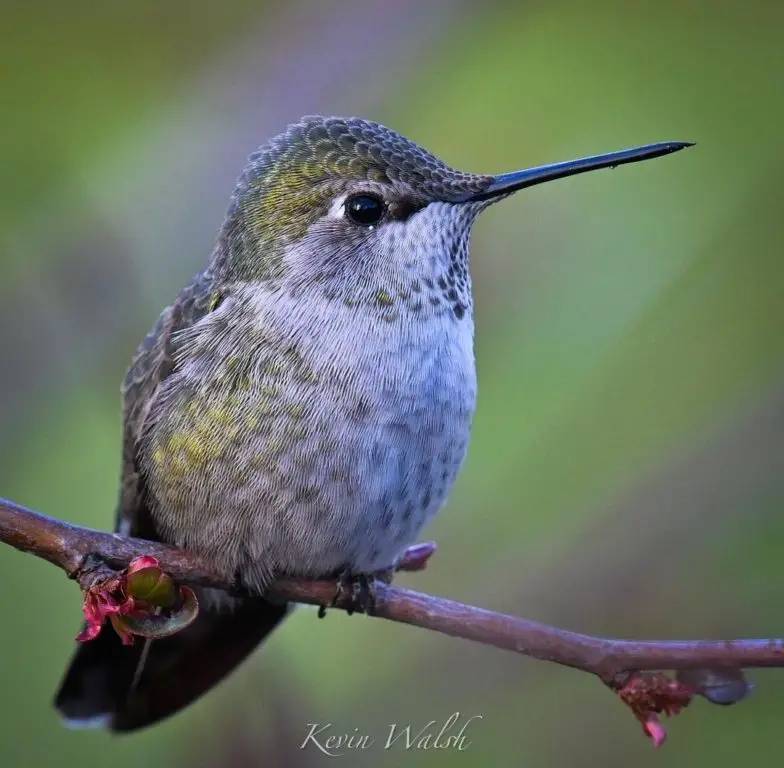
Photo by: Kevin Walsh
To see the current sighting map of Alaska’s Anna’s hummingbirds, click the link.
Hear the sounds of the Anna’s hummingbird (Cornell Lab of Ornithology link).
18% of all Alaska hummingbird sightings will be Anna’s hummingbirds.
On average, out of 10,000 hummingbird sightings in Alaska, 1,767 will be of the Anna’s hummingbird.
The only hummingbird to reside year-round on the Pacific Coast, the Anna’s hummingbird is a native of the west coast of North America. It enjoys a Mediterranean climate with hot, dry summers and fairly wet winters.
This species is a year-round resident in much of its range, unlike many other hummingbirds that migrate.
Male Anna’s are notable for their remarkable diving displays during mating season and their ability to thrive in urbanized areas.
The male Anna’s hummingbird executes dramatic and captivating displays during courtship and diving. The entire dive display lasts 12 seconds from start to finish.
See my article: Hummingbird Dance: 5 Interpretive Explanations
Unlike many northern temperate hummingbirds, male Anna’s hummingbirds sing during courtship along with making vibrations with their tail feathers to attract a female.
Anna’s hummingbirds protect their territory with elaborate dives targeted towards predatory birds and even towards people they perceive to be threatening.
See my article: Why Hummingbirds Chase Each Other: Is it Friend or Foe?
Anna’s hummingbirds hybridize and readily crossbreed with other hummingbird species, such as the Black-chinned, Costa’s, and Rufous hummingbirds.
The oldest male Anna’s hummingbird known to exist was 8 years and 2 months old when he was captured and released during a banding expedition in Arizona.
See my article: 3 Reasons Why Hummingbirds Are Banded
Alaska Hummingbirds That Are Rare/Vagrant
There are 3 Alaska hummingbirds classified as rare or vagrant hummingbirds. They are Costa’s, Calliope, and Ruby-throated hummingbirds.
Hummingbirds that live in a group outside of their typical geographic range are classified as belonging to this category. These hummingbird species not only span a vast range of distinct geographic areas, but they are also known to occasionally interbreed, giving rise to hybrids.
Although they are not in their usual range, reports of seeing these hummingbirds in Alaska have been made.
COSTA’S HUMMINGBIRD – (Calypte costae)
Conservation Status: Least concerned
Kingdom: Animalia
Phylum: Chordata
Class: Aves
Order: Apodiformes
Family: Trochilidae
Genus: Calypte
Species: C. costae
The scientific name of Costa’s Hummingbird is Calypte costae.
Jules Bourcier named the Costa’s hummingbird in 1839 in honor of Louis Marie Pantaleon Costa, a French naturalist, and ardent hummingbird collector.
He was recognized for his contributions to the field, and thus, the bird was named in his honor. This practice of naming species after people, especially those who have made significant contributions to science or natural history, is quite common in taxonomy.
Male Costa’s hummingbirds:
The male Costa’s hummingbird is a small and vibrant bird, easily recognizable by its distinct coloration and features. It possesses a bright reddish-purple cap, which covers the head feathers, and a similarly colored gorget, which is the area around the throat. Unique to this species, the gorget displays long streaming throat feathers that extend on both sides of its face, bearing a resemblance to the feather arrangement found in Calliope hummingbirds.
The metal plate that shields the wearer’s throat during combat to prevent injuries is the inspiration behind the name of the gorget on a male hummingbird. This name is acceptable and fitting to characterize the physical characteristics of male hummingbirds, since they fight fiercely for their own territory.
Read my article: Hummingbird Gorgets Explained
In contrast to the vivid colors of its head and throat, the male Costa’s hummingbird has a subdued body coloration. Its underbelly is light greenish-gray, providing a soft counterbalance to the brilliance of its head. The back and flanks of the bird display a green hue, seamlessly blending with its natural habitats. Regarding its size, the male Costa’s hummingbird is relatively small, measuring between 3 to 3.5 inches in length, and is lightweight, tipping the scales at just 2 to 3 grams.
This combination of striking head and throat colors with its more muted body tones makes the male Costa’s hummingbird a distinctive and easily identifiable species among hummingbirds.
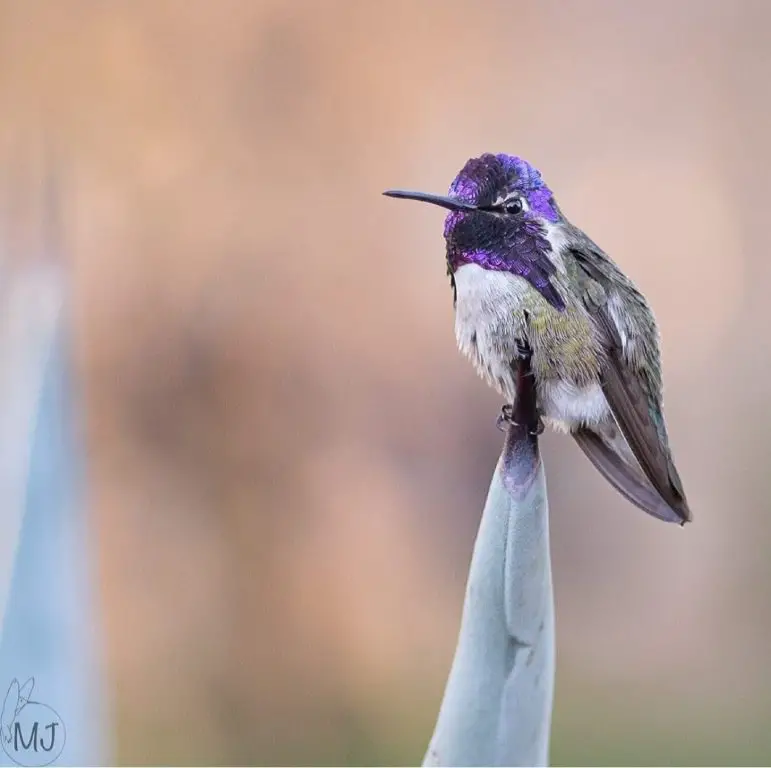
Photo by: hummingbirdsbysuprise
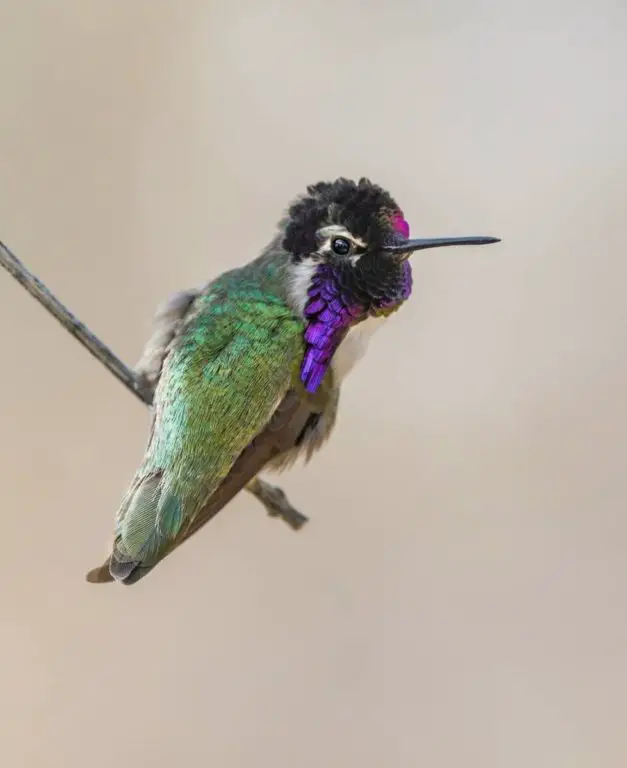
Photo by: bird.whisperer
Female Costa’s hummingbirds:
The female Costa’s hummingbird presents a more subdued appearance compared to the strikingly vibrant males. Lacking the iridescent feathers that characterize their male counterparts, female Costa’s hummingbirds display a more understated coloration.
Their grayish-light-green back is a muted hue that blends easily with the environment. This coloring provides excellent camouflage, especially in the bird’s natural habitats. The underbelly is a dusty white, further contributing to their less conspicuous appearance. This contrast between the slightly darker back and the lighter underbelly, while subtle, still offers a distinctive look within the species.
The absence of the bright colors and iridescent feathers found in males is a common trait in many bird species, where females often have more subdued coloration, possibly as an evolutionary adaptation for better concealment while nesting and raising young.
See my article: Hummingbird Parents: (Mating to Nesting)
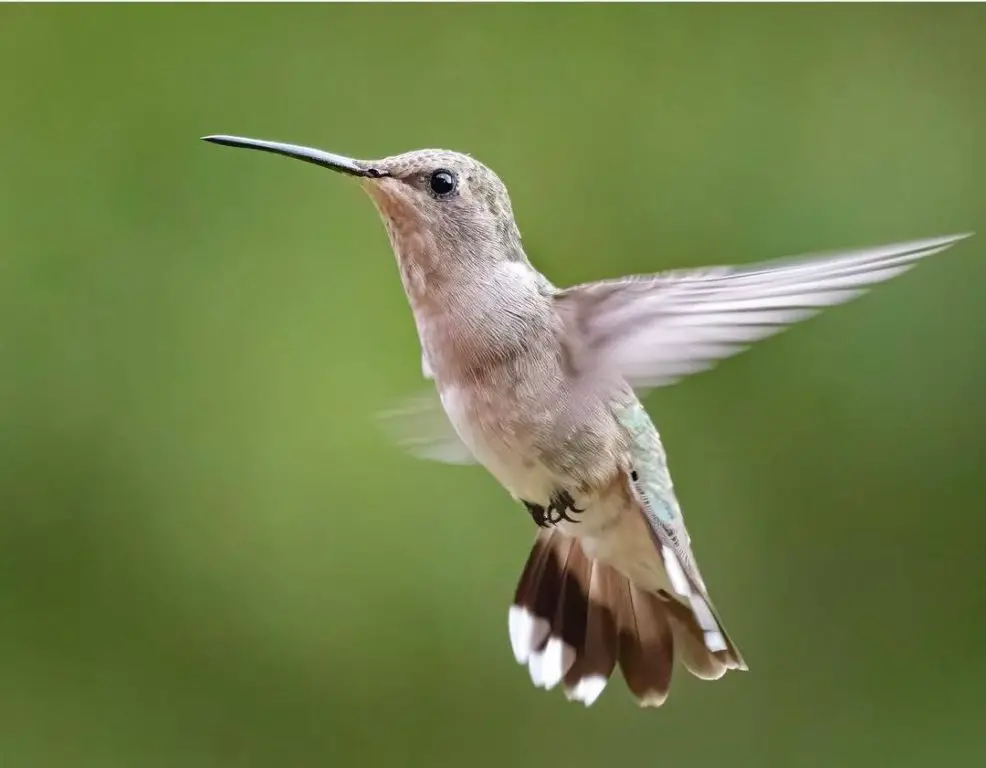
Photo By: Aaron Gomperts
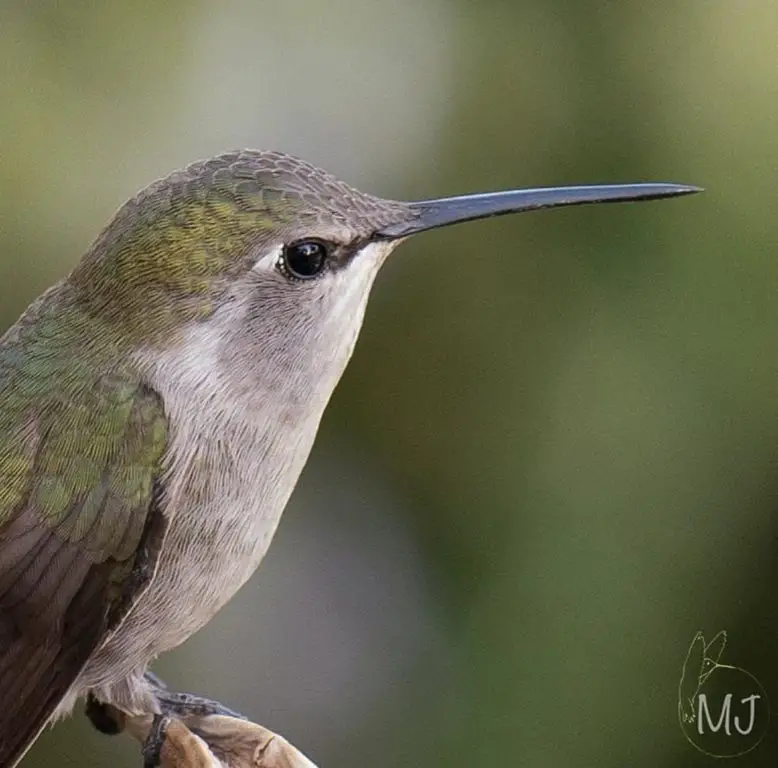
Photo by: hummingbirdsbysuprise
Female Costa’s hummingbirds migrate north from Mexico to breed in Arizona, California, Nevada, and Utah.
Being a desert-dwelling species, Costa’s hummingbirds nest in open spaces with little vegetation. It has been observed that they build their nests on cacti. Predators that might try to consume the eggs or nestlings are discouraged from doing so by the plant’s thorns.
Read my article: 10 Common Things That Kill Hummingbirds
Juvenile Costa’s hummingbirds:
Both male and female juvenile Costa’s hummingbirds look more like adult females until they are differentiated as the male begins to acquire the iridescent feathers that are typical for males of this species of hummingbird.
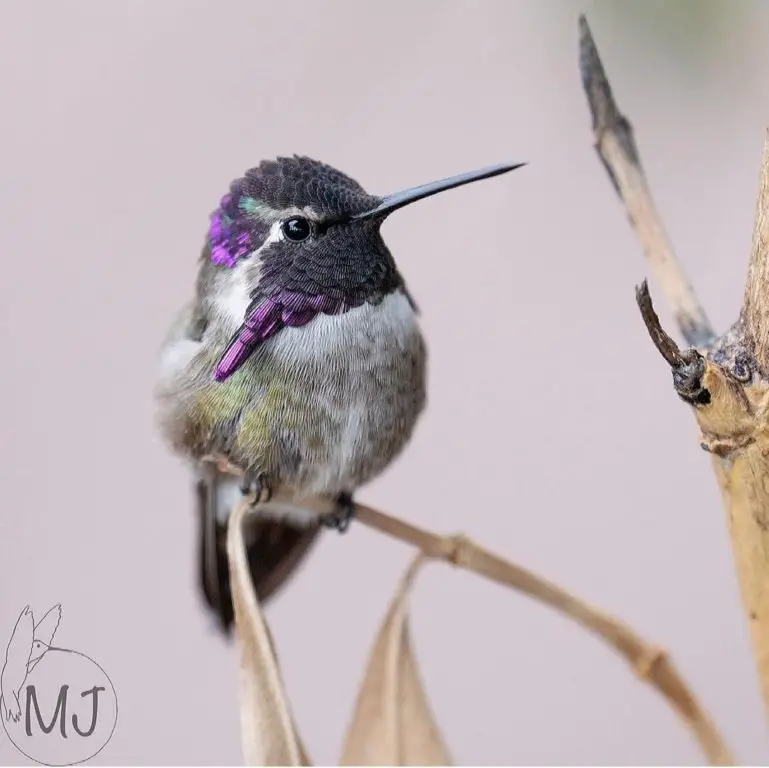
Photo by: hummingbirdsbysuprise
Note: His bright throat feathers are slowly coming in.
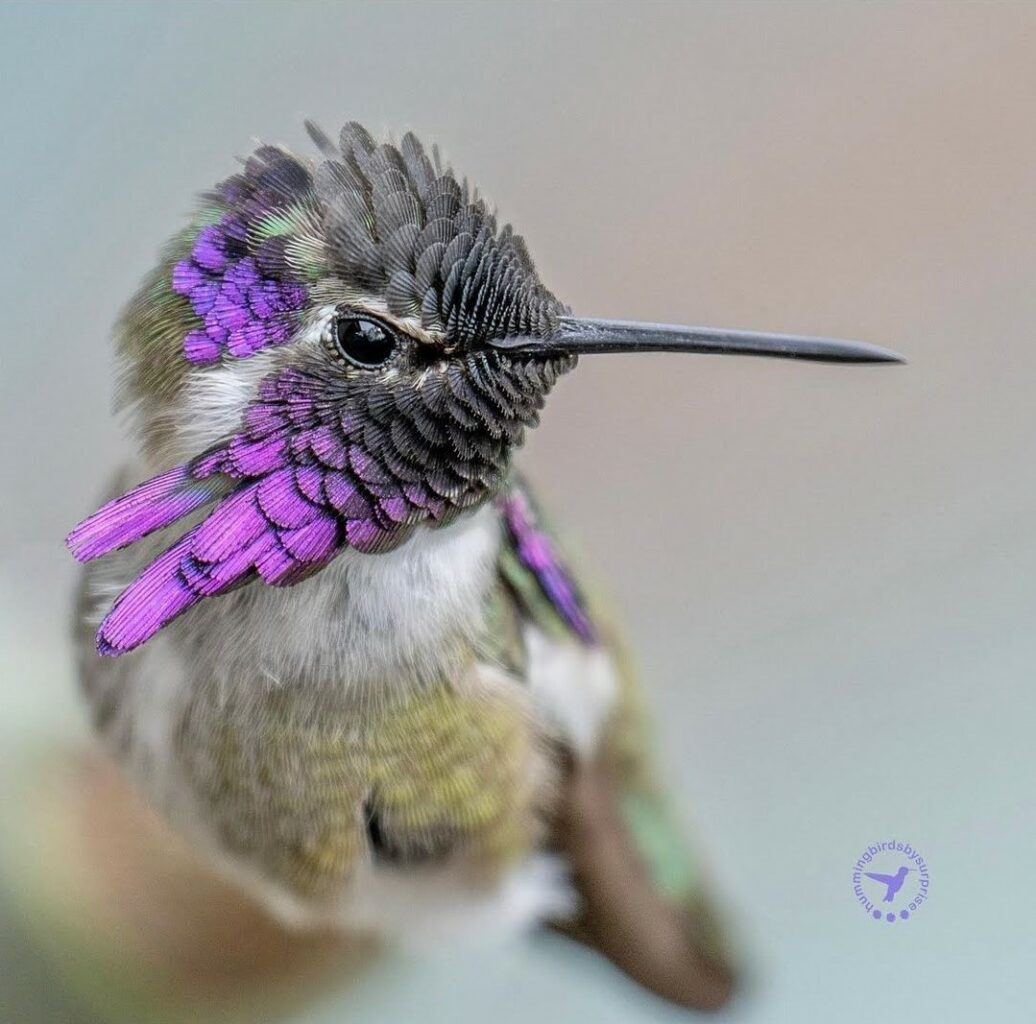
Photo by: hummingbirdbysuprise
Baby Costa’s hummingbirds:
Baby Costa’s hummingbirds are easily identified by their undertail coverts, which are white fluffy feathers near their bottom that will disappear as they age.
See my article: Baby Hummingbirds: (Egg to Fledgling)
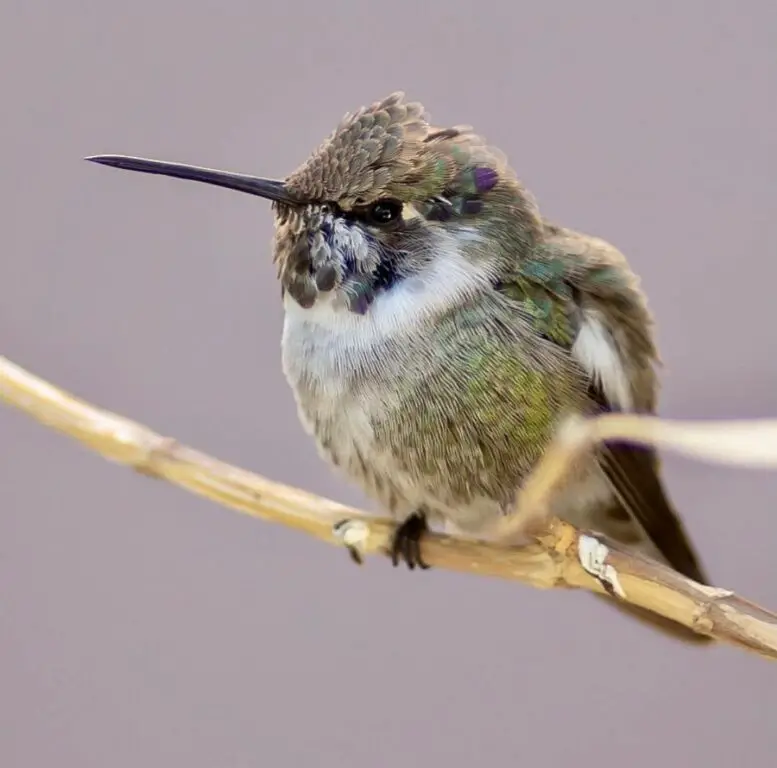
Photo by: hummingbirdbysuprise
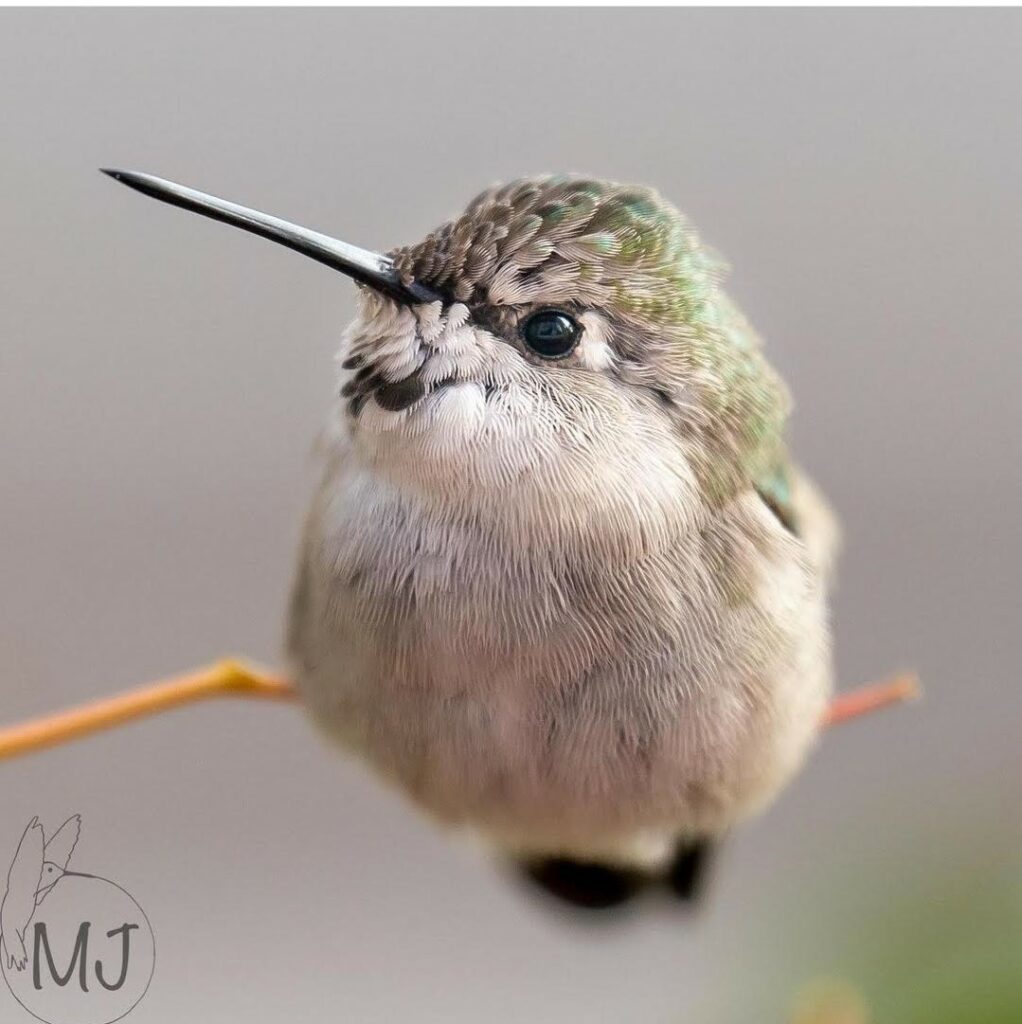
Photo by: hummingbirdsbysuprise
To see the current sighting map of Alaska’s Costa’s hummingbirds, click the link.
Hear the sounds of the Costa’s hummingbird (Cornell Lab of Ornithology link).
0.54% of all Alaska hummingbird sightings will be Costa’s hummingbirds. hummingbirds.
On average, out of 10,000 hummingbird sightings in Alaska, only 54 will be of the Costa’s hummingbird.
Very little is known about Costa’s hummingbirds and their short migratory habits in comparison to other hummingbird species.
Costa’s hummingbirds are primarily found in arid and semi-arid environments, including deserts, scrublands, and chaparral regions. They are native to the southwestern United States and Baja California in Mexico. These birds are well-adapted to their dry habitats, often found in areas with abundant flowering plants which are crucial for their survival.
In terms of social behavior, Costa’s hummingbirds are generally solitary, especially outside of the breeding season. They can be territorial, with males often defending prime feeding territories from other hummingbirds.
See my article: Why Hummingbirds Chase Each Other: Is it Friend or Foe?
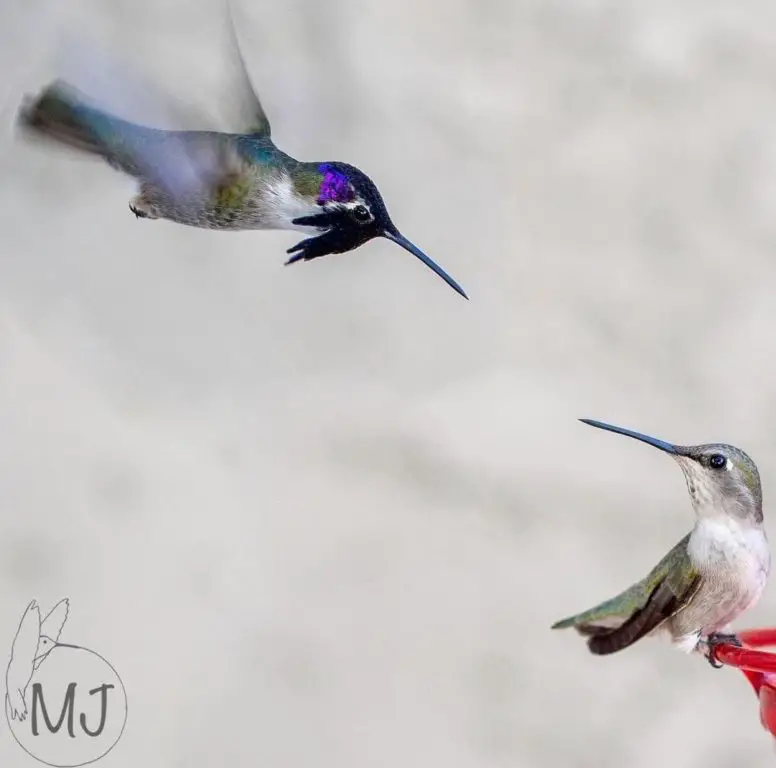
Photo by: hummingbirdsbysuprise
Although Costa’s hummingbirds will defend nectar sources amongst themselves, they are subordinate to larger hummingbirds and will defer to them if challenged.
The Costa’s hummingbird is a partially migratory species. During the winter, birds in the northern portion of their range—especially those found in the United States—usually migrate southward to warmer climes. People in the southern portion of their range, particularly in Mexico, are frequently non-migratory.
Living in dry habitats, Costa’s hummingbirds have developed adaptations to survive in these conditions. They are efficient in their water usage and can tolerate higher temperatures than many other bird species. Their choice of flowering plants also reflects their adaptation to their environment, often favoring those that thrive in arid conditions.
Costa’s hummingbirds are known to interbreed or cross-breed, producing hybrids between Anna’s, Black-chinned, Blue-throated, Broad-tailed, and Calliope hummingbirds.
The biggest danger facing Costa’s hummingbirds is human encroachment, which takes the shape of plowed desert areas cleared for habitation and grazing.
The oldest known female Costa’s hummingbird lived for 8 years and 9 months after being caught and released twice during a banding operation in California in 2001 and 2009.
See my article: 3 Reasons Why Hummingbirds Are Banded
CALLIOPE HUMMINGBIRD – (Selasphorus calliope)
Conservation Status: Least concerned
Kingdom: Animalia
Phylum: Chordata
Class: Aves
Order: Apodiformes
Family: Trochilidae
Genus: Selasphorus
Species: S. calliope
Calliope hummingbirds are named after a Greek mythological muse, who represented poetry and eloquence. Calliope means “beautiful voice” in ancient Greek.
Male Calliope hummingbirds:
The long, stunning row of feathers that protrude down the sides of the throat and their iridescent purple cap are characteristics that make male Calliope hummingbirds clearly identifiable.
These hummingbirds, which are 3 inches long and weigh 2-3 grams, have shiny green backs like many others.
The metal plate that shields the wearer’s throat during combat to prevent injuries is the inspiration behind the name of the gorget on a male hummingbird. This name is acceptable and fitting to characterize the physical characteristics of male hummingbirds, since they fight fiercely for their own territory.
Read my article: Hummingbird Gorgets Explained
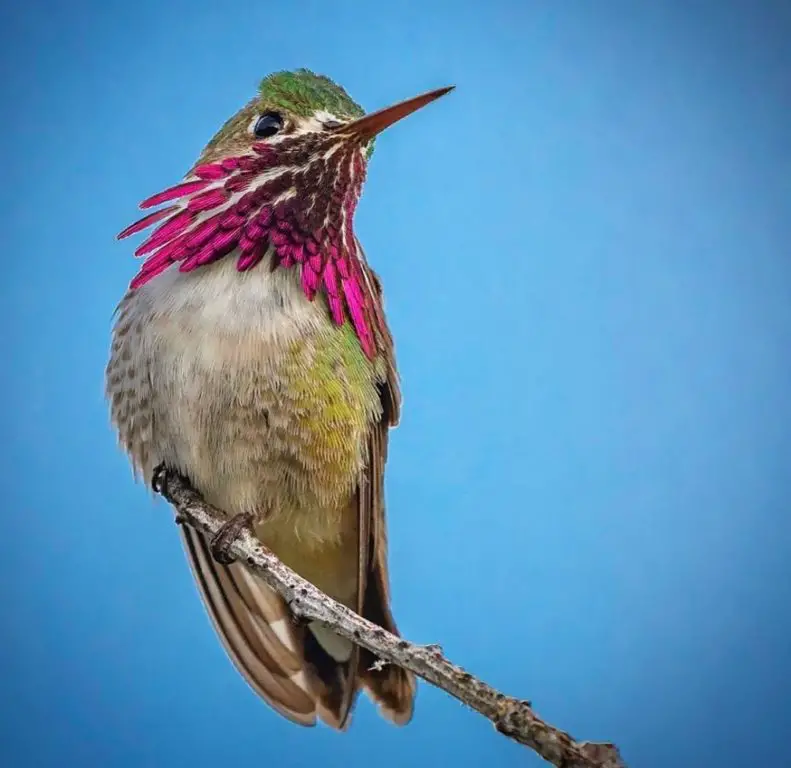
Photo by: sony_alpha_male
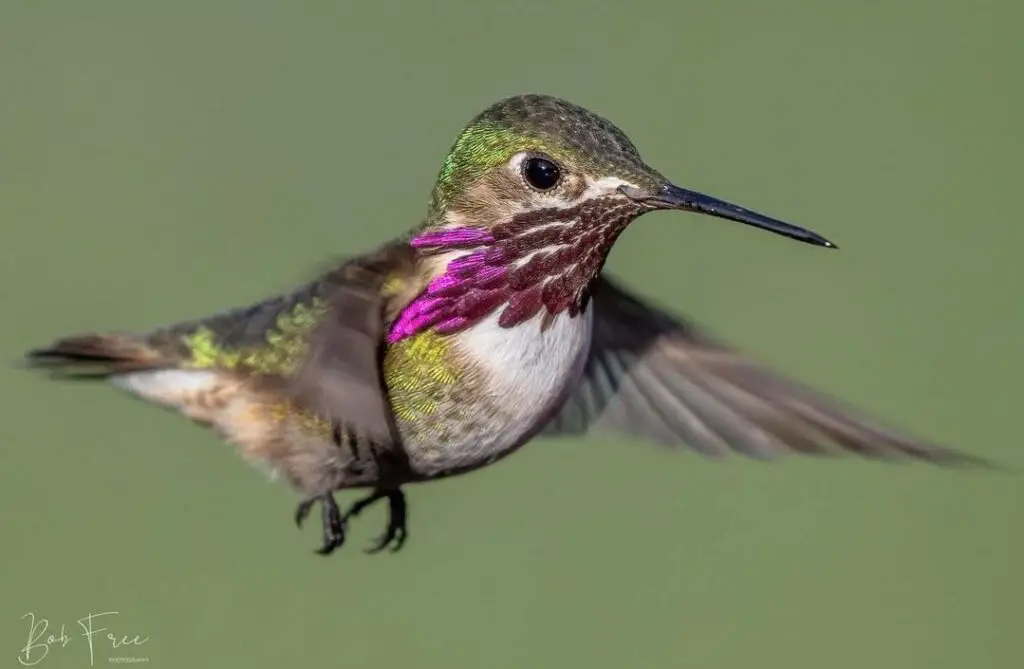
Photo by: Bob Free
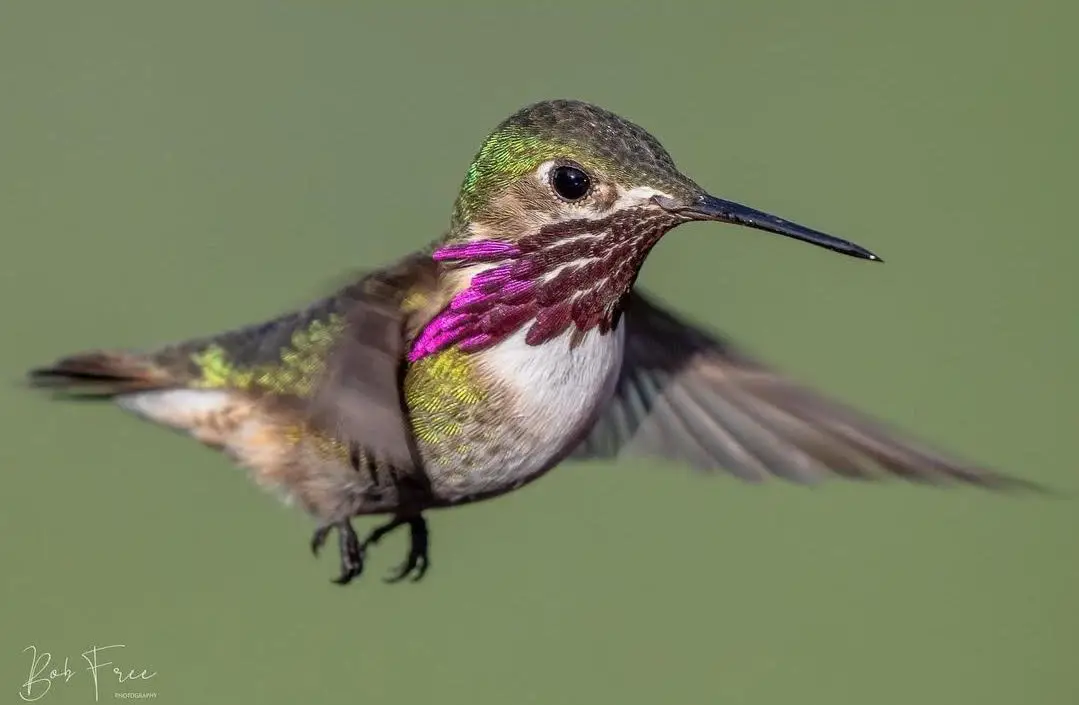
Photo by: Bob Free
Female Calliope hummingbirds:
The female Calliope hummingbird is less colorful than the male and lacks a gorget and iridescent feathers. Their head’s crown, or top, has a grayish-green hue. The buff hue of the flanks refers to the sides, underbelly, and area beneath the wings.
See my article: Hummingbird Parents: (Mating to Nesting)
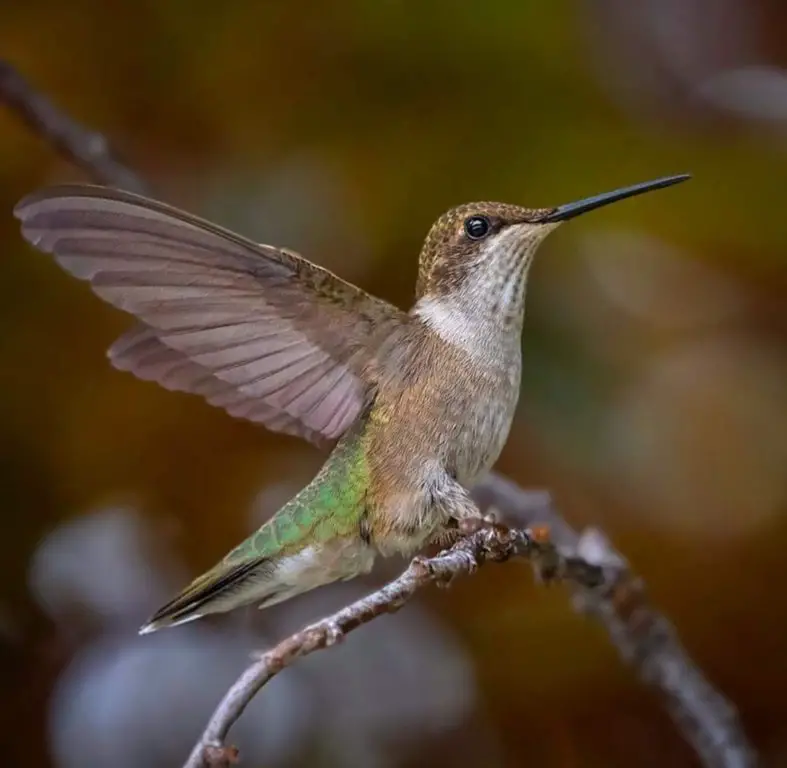
Photo by: sony_alpha_male
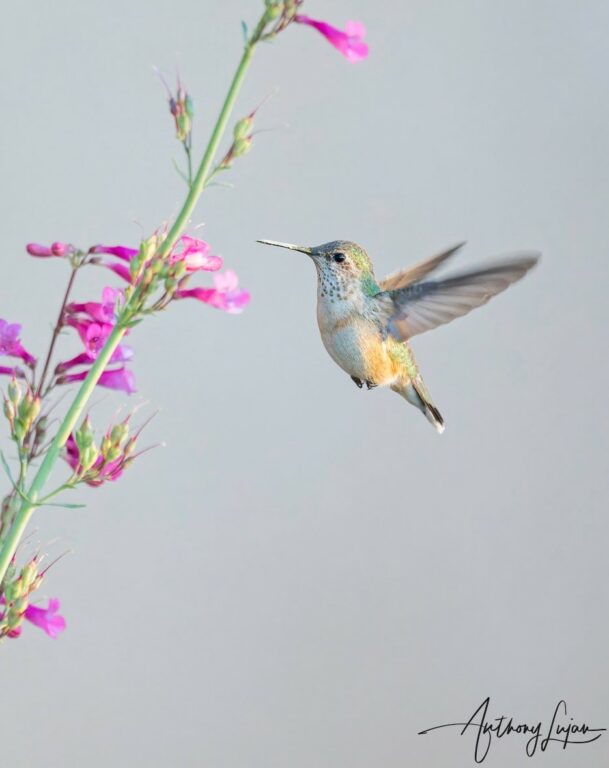
Photo by: Anthony Lujan

Photo by: Anthony Lujan
Juvenile Calliope hummingbirds:
Male and female juvenile Calliope hummingbirds initially resemble adult females until the male starts to develop the iridescent feathers that are characteristic of this species of hummingbird.
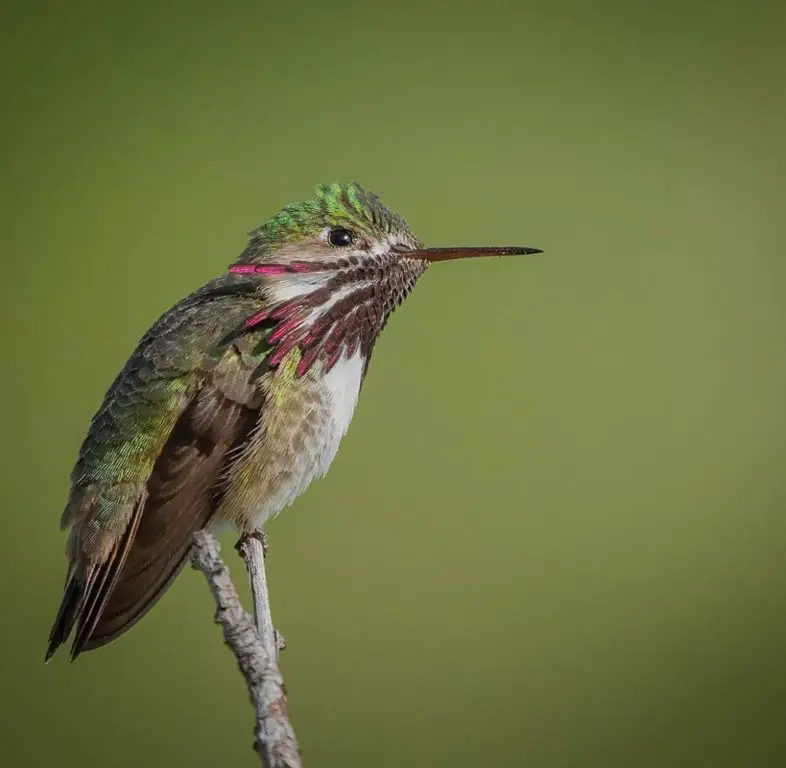
Photo by: sony_alpha_male
Note: His bright throat feathers are slowly coming in.
Baby Calliope hummingbirds:
Baby Calliope hummingbirds are easily identified by their undertail coverts, which are white fluffy feathers near their bottom that will disappear as they age.
See my article: Baby Hummingbirds: (Egg to Fledgling)
To see the current sighting map of the Calliope hummingbird in Alaska, click the link.
Hear the sounds of the Calliope hummingbird. (Cornell Lab of Ornithology link).
0.04% of all Alaska hummingbird sightings will be Calliope hummingbirds.
On average, out of 10,000 hummingbird sightings in Alaska, 4 will be the Calliope hummingbird.
Like many other hummingbirds, Calliopes use their feathers to manipulate their flight path in order to produce a variety of buzzing noises that serve as a type of language.
The male will fervently fly back and forth and perform a “U” shaped courtship display to get the attention of the female when she is quietly perched. The male hummingbird will perform a vocal serenade for the female while swaying his body back and forth in front of her.
See my article: Hummingbird Dance: 5 Interpretive Explanations
A breeding area is established by male Calliope hummingbirds, who mate with any female that accepts their wooing.
In terms of social behavior, Lucifer Hummingbirds are generally solitary, especially outside of the breeding season. They can be territorial, with males often defending prime feeding territories from other hummingbirds.
See my article: Why Hummingbirds Chase Each Other: Is it Friend or Foe?
Calliope hummingbirds hybridize and readily crossbreed with other hummingbird species, such as the Costa’s hummingbird.
The female Calliope selects the tips of pine cones as her building site for building her nest. Along with stealing materials from other birds’ nests to build her own, she will also disassemble and recycle previous seasons’ nests on her own.
Therefore, larger and more aggressive hummingbirds, such as Allen’s and Rufous hummingbirds, frequently chase and attack female Calliopes. Compared to other species, the Calliope keeps a low profile in order to evade these attacks.
The world’s smallest long-distance migratory bird is the Calliope hummingbird. Their springtime migration patterns resemble those of Rufous hummingbirds. Throughout their northward spring migration, they traverse the Pacific Flyways.
On their southbound journey in the fall, they pass through the Pacific and Rocky Mountain Flyways towards their wintering destination in Mexico.
Calliope hummingbirds are especially susceptible to habitat loss and natural catastrophes like wildfires and climate change because they have a smaller wintering range than other hummingbird species.
The oldest known female Calliope hummingbird was twice captured during a 2007 and 2014 banding operation in Idaho. She was 8 years and 11 months old at the time of her capture.
See my article: 3 Reasons Why Hummingbirds Are Banded
RUBY-THROATED HUMMINGBIRD – (Archilochus colubris)
Conservation Status: Least concerned
Kingdom: Animalia
Phylum: Chordata
Class: Aves
Order: Apodiformes
Family: Trochilidae
Genus: Archilochus
Species: A. colubris
Scientist Carl Linnaeus of Sweden is credited with giving the Ruby-throated hummingbird its scientific name. He initially classified the species as “Trochilus colubris.” Its name was revised more than a century later when German botanist Ludwig Reichenbach classed it as “Archilochus colubris,” which is now its scientific name and means “sky spirit/sun-god bird” or “top thief.”
Male Ruby-throated hummingbirds:
The beautiful iridescent blood-red gorget of male ruby-throated hummingbirds ends at the neck.
His distinctive features are black wings, a light gray underbelly, and a dull metallic green topside.
The Ruby-throated Hummingbird is a tiny species of hummingbird, measuring 2.8 to 3.3 inches in length and weighing less than 4.5 grams, or two U.S. dimes.
They live for three to five years on average.
The metal plate that shields the wearer’s throat during combat to prevent injuries is the inspiration behind the name of the gorget on a male hummingbird. This name is acceptable and fitting to characterize the physical characteristics of male hummingbirds, since they fight fiercely for their own territory.
Read my article: Hummingbird Gorgets Explained
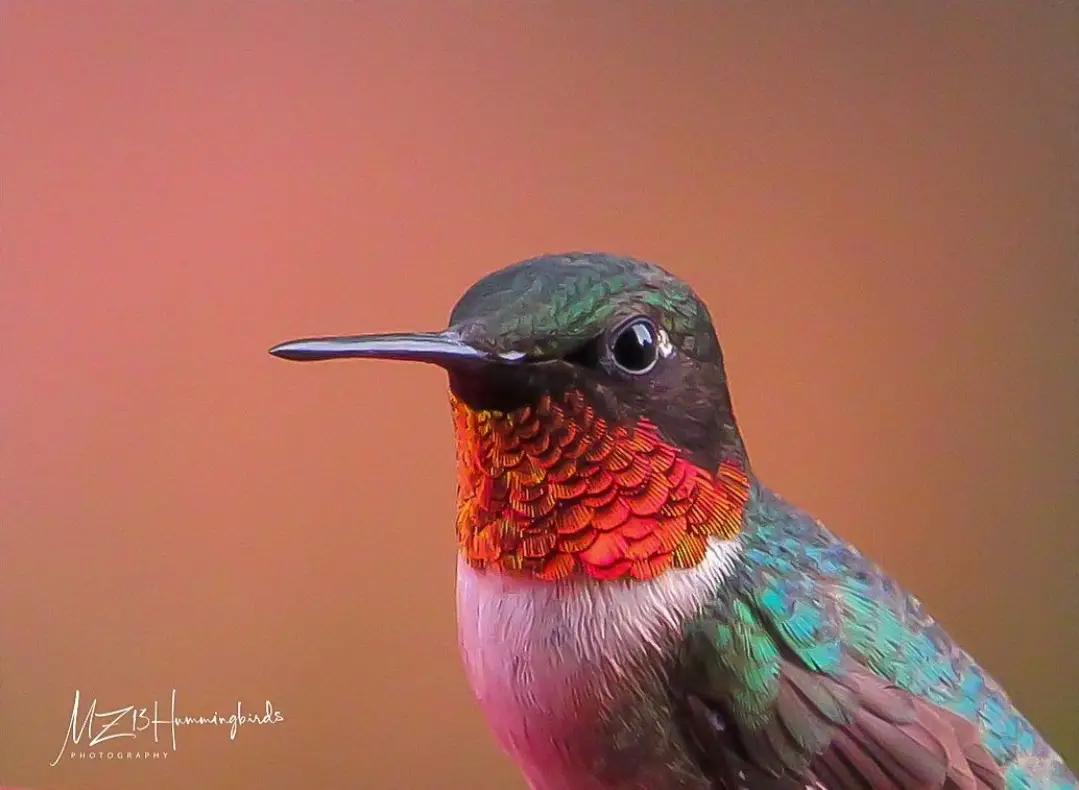
Photo by: mz13hummingbirds
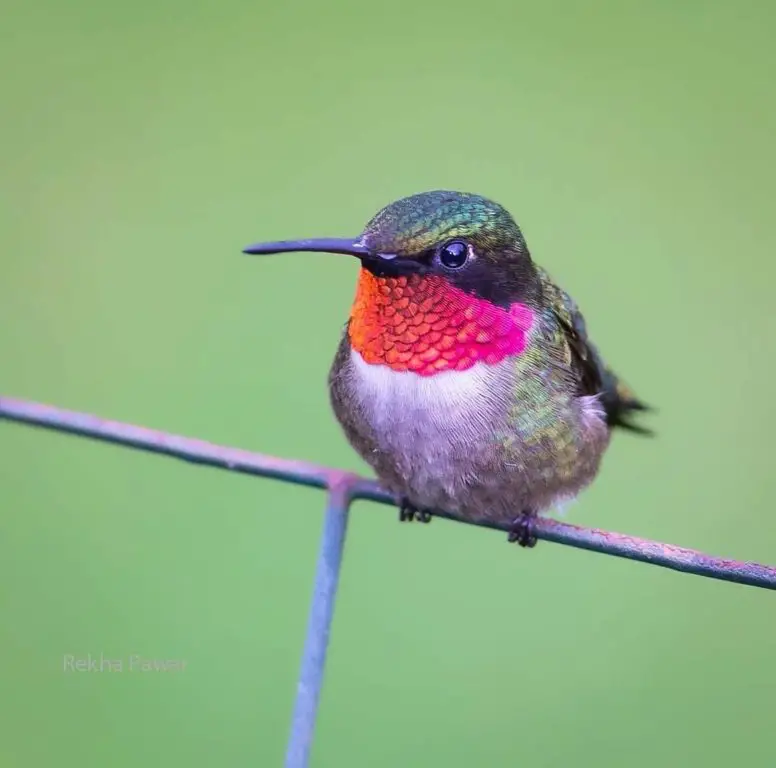
Photo by: Rekha Pawar
Female Ruby-throated hummingbirds:
Ruby-throated hummingbird females are usually larger than males, with a white throat stippled with light spots.
Ruby-throated hummingbird’s life expectancy is roughly three to five years.
The oldest female Ruby-throated hummingbird on record, at nine years old, is nearly twice as old as the male life expectancy.
See my article: Hummingbird Parents: (Mating to Nesting)
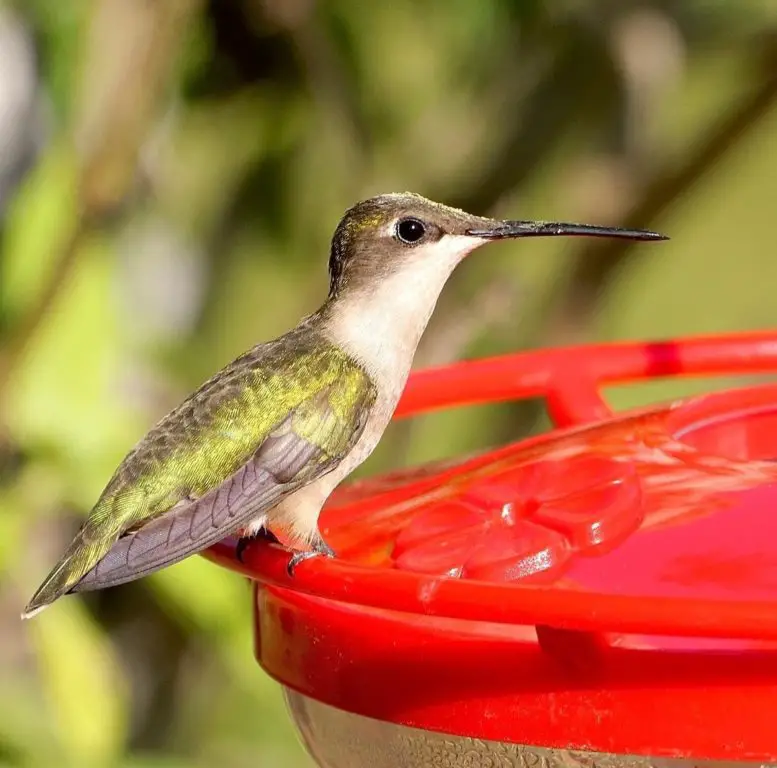
Photo by: Dgen.photos
Note: The pollen on her head and beak. This female Ruby-throated hummingbird has been busy pollinating and drinking nectar from flowers to sustain her high metabolism.
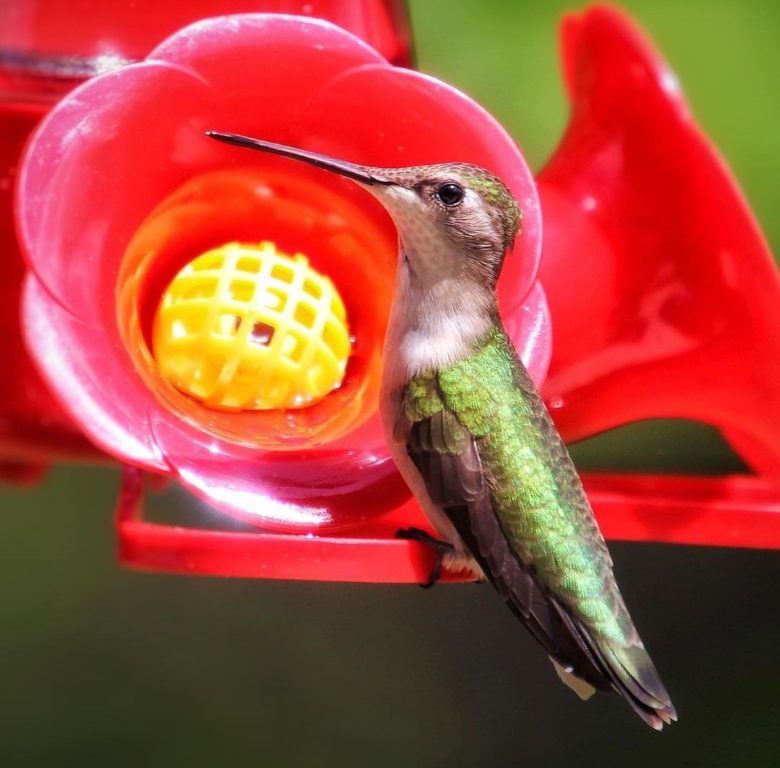
Photo by: paulapaintsart
Juvenile Ruby-throated hummingbirds:
Ruby-throated hummingbird juveniles, both male and female, have a white throat with faint stippling, just like their mother.
As the males become older, they start to show some color around their necks, and finally their stronger red throat feathers take center stage and proudly show off a vibrant gorget.
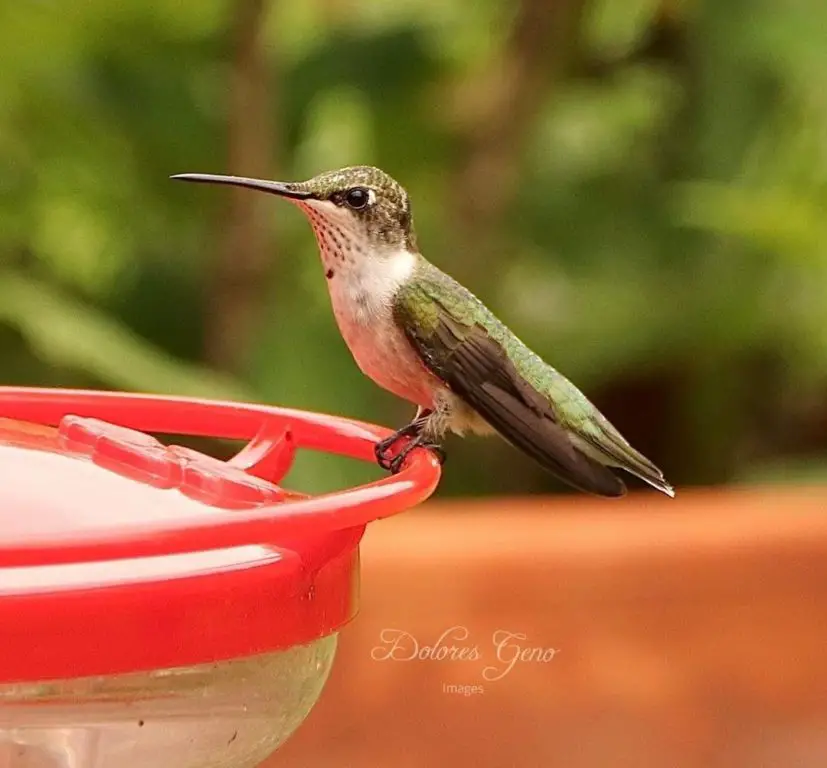
Photo by: Dgen.photos
Note: His throat feathers are slowly coming in, displaying a few dots of color near his neckline and showing the first stages of adolescence.
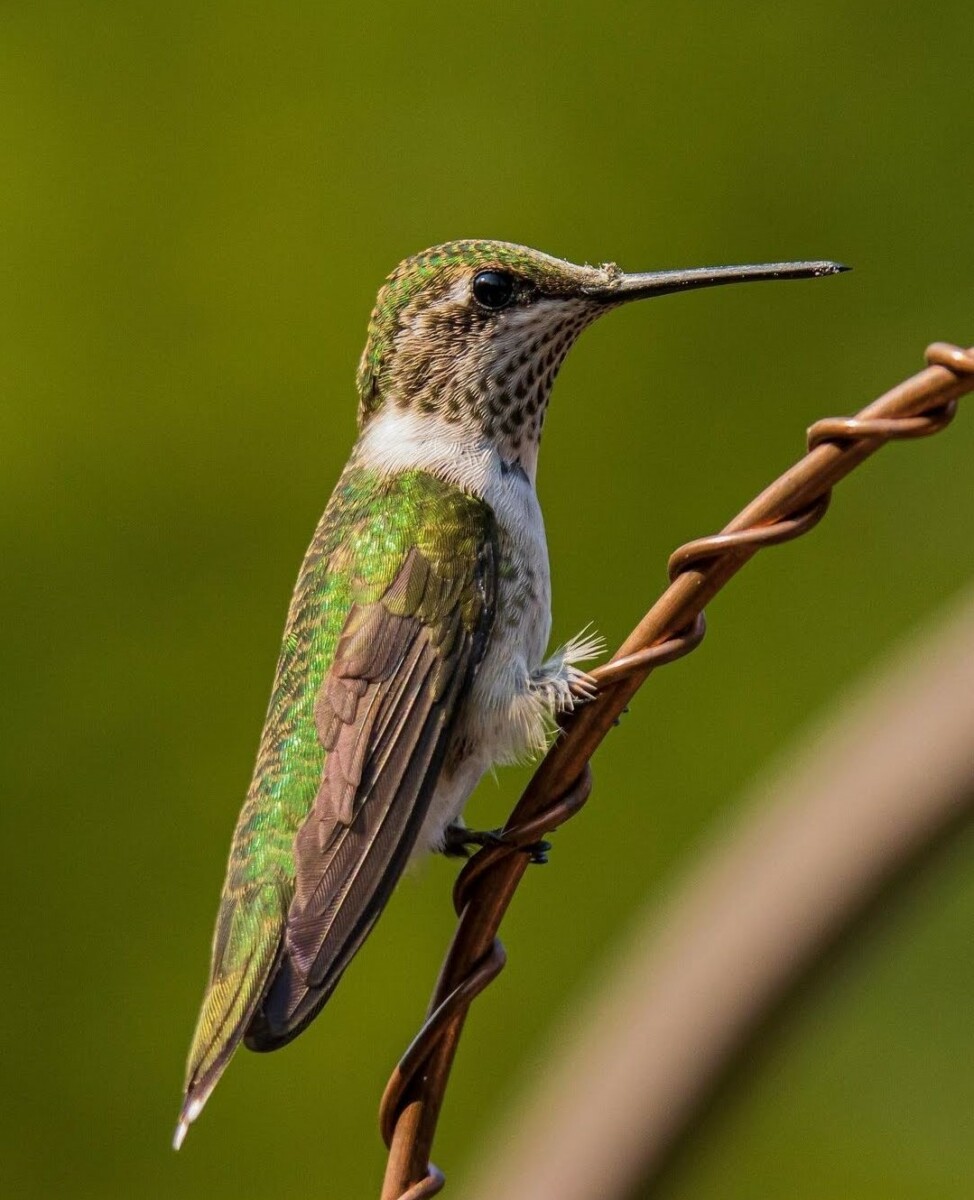
Photo by: MaryLou Ziebarth
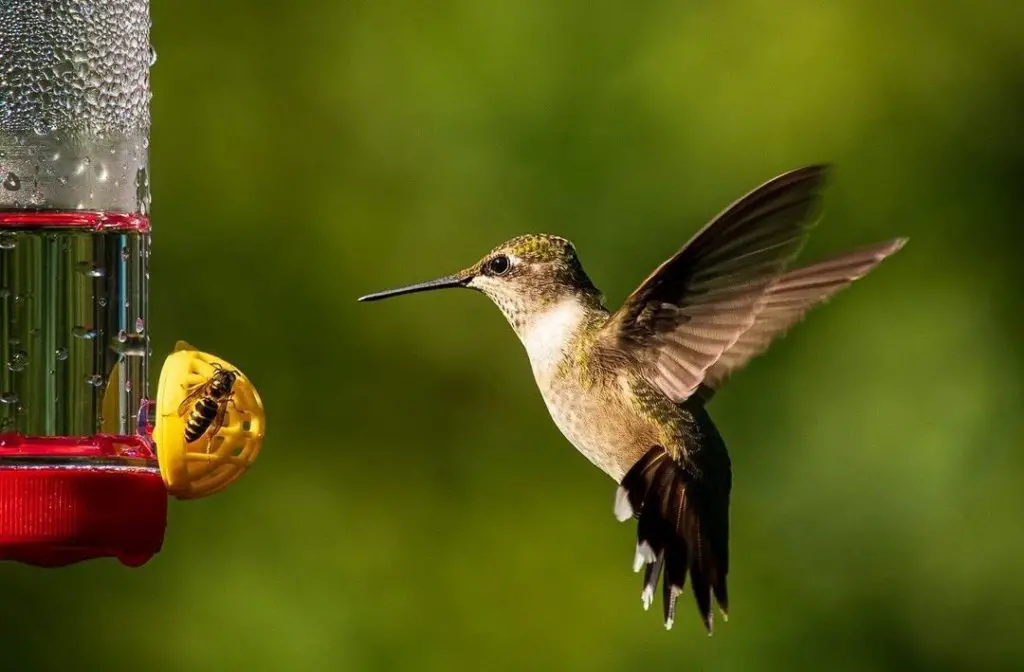
Photo by: MaryLou Ziebarth
Note: This juvenile Ruby-throated hummingbird is struggling with a bee or wasp situation at the feeder.
See my article: Bees On My Hummingbird Feeder: (9 Tips To Get Rid of Them)
Baby Ruby-throated hummingbirds:
Baby Ruby-throated hummingbirds are easily identified by their undertail coverts, which are white fluffy feathers near their bottom that will disappear as they age.
See my article: Baby Hummingbirds: (Egg to Fledgling)
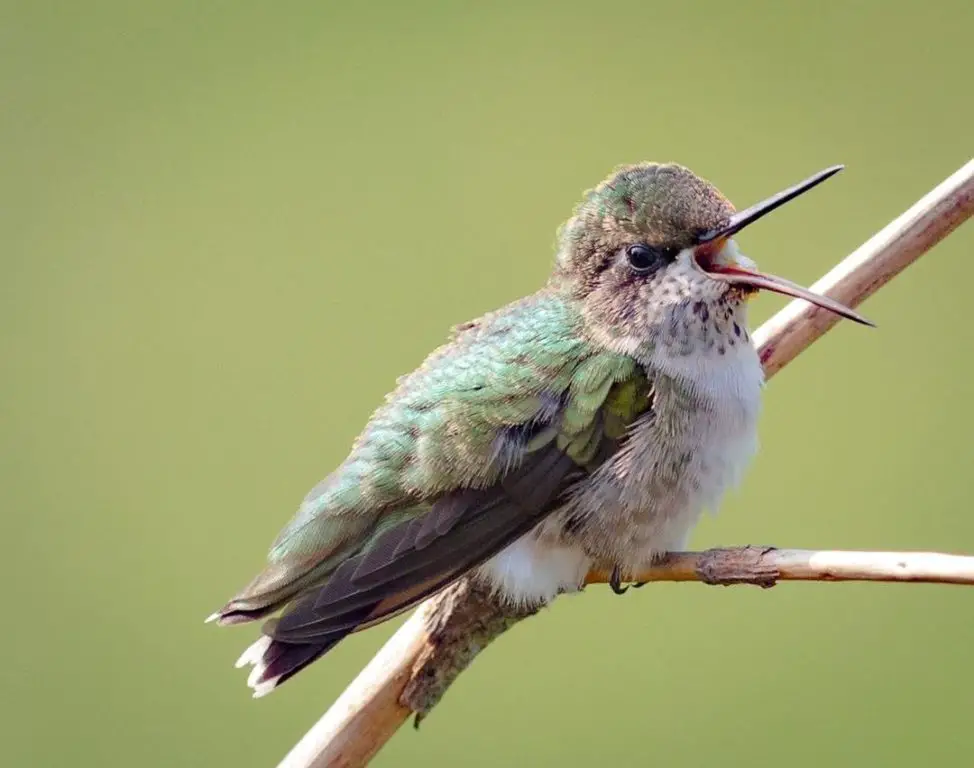
Photo by: Rekha Pawar
Note: The down feathers near the baby’s bottom are newly white and fluffy.
Also, observe the great fat reserves they have amassed from the feedings of their devoted mother’s, which will help them get through puberty.
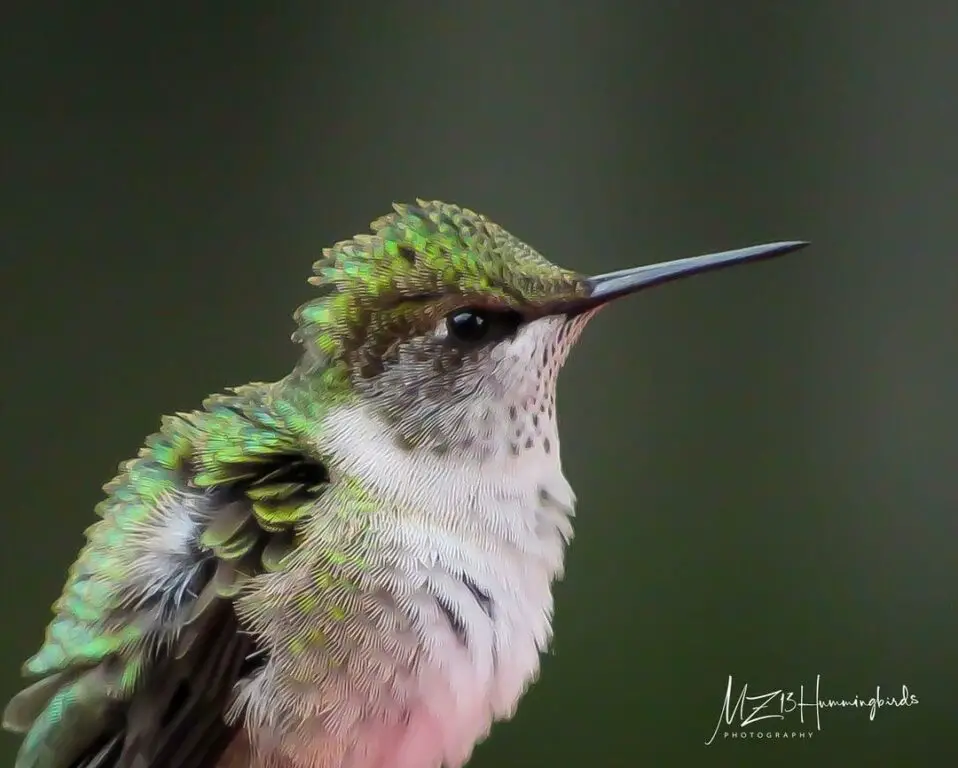
Photo by: Mz13hummingbirds
To see the current sighting map of Alaska’s Ruby-throated hummingbirds, click the link.
Hear the sounds of the Ruby-throated hummingbird (Cornell Lab of Ornithology link).
0.02% of all Alaska hummingbird sightings will be Ruby-throated hummingbirds.
On average, out of 10,000 hummingbird sightings in Alaska, only 2 will be of the Ruby-throated hummingbird.
The Ruby-throated Hummingbird migrates via two different routes in the spring and fall.
The first migration route takes them directly, via the Gulf of Mexico, southwest to Mexico, where they travel nonstop and exhaustingly until they reach Central America for the winter. Over 500 miles is the flight distance over the Gulf of Mexico. Despite being the direct “short” route, these birds must overcome many difficulties.
Not being able to rest, not having access to food or fuel, and needing to steer clear of the severe tropical Atlantic hurricanes while traveling to their destination are some of the challenges faced when flying over the Gulf of Mexico. To exacerbate the situation, they migrate during the night or are conducting a “Red-eye flight,” depending on your point of view.
Even though both sexes double their body fat before beginning their arduous transoceanic migratory pattern across the Gulf of Mexico, researchers think that males’ energy consumption is more taxing due to their small stature.
The second land migration path follows the Gulf of Mexico’s shoreline. Even though there are fewer guarantees of food sources along the way, taking the “long” route gives them the chance to stop and replenish.
Scientists are unclear and continue to investigate why one group of birds would prefer to take one route over the other.
Read my article: Alaska Hummingbird Migration
The most likely hummingbird to be seen in an Alaska winter would be the Rufous hummingbird.
The majority of people are unaware of how tolerant hummingbirds are of chilly weather.
According to eBird.org, through branding practices in Wisconsin, the Ruby-throated and Rufous hummingbirds have been documented surviving in temperatures of -9F and wind chills of -36F.
See my article: 3 Reasons Why Hummingbirds Are Banded
To provide the many hummingbirds that spend the winter in Alaska access to life-sustaining nectar, several Alaskan hummingbird enthusiasts keep their hummingbird feeders up all winter long.
This altruistic deed also supplies nectar to other migrating species that are too injured or elderly to travel.
See my article: 11 DIY Ways to Keep Hummingbird Nectar From Freezing
The Ruby-throated hummingbird is a common sight in parks, gardens, and backyards. It prefers open forests. Except for the breeding season, when they become ferociously territorial and hostile against hummingbirds of other species, they are solitary birds.
Despite their aggressive nature, these hummingbirds are eaten by predators like dragonflies, big crustaceans, praying mantises, and orb-weaver spiders.
Read my article: 10 Common Things That Kill Hummingbirds
Nine years and one month was the oldest known living female Ruby-throated hummingbird, found during a capture and release banding operation in West Virginia.
Read my article: 3 Reasons Why Hummingbirds Are Banded
Which Alaska Hummingbirds Are Most Frequently Seen In The State?
The most frequently seen Alaska hummingbirds are the Rufous hummingbird, followed by the Anna’s hummingbird.
81% of all hummingbirds seen in Alaska will be Rufous hummingbirds.
18% of all hummingbirds seen in Alaska will be Anna’s hummingbirds.
The remaining 1% of Alaska hummingbirds are a mix of Costa’s, Calliope, and Ruby-throated hummingbirds.
Where In The State Are Alaska Hummingbirds Seen?
Hummingbirds are seen in Alaska along the southern coastline of the Pacific Ocean which extends slightly inland.
To see the current areas where a specific hummingbird is documented, as seen in Alaska, click the link below to see a sighting map from eBird.
- Rufous hummingbirds seen in Alaska
- Anna’s hummingbirds seen in Alaska
- Costa’s hummingbirds seen in Alaska
- Calliope hummingbirds seen in Alaska
- Ruby-throated hummingbirds seen in Alaska
Read my article: Alaska Hummingbird Migration
For more information about hummingbirds, read my other hummingbird articles.
Happy Hummingbird Watching!
Backyard Visitors is a participant in the Amazon Services LLC Associates Program, an affiliate advertising program designed to provide a means for sites to earn advertising fees by advertising and linking to Amazon.com. We also participate in other affiliate programs which compensate us for referring traffic.

